Lexicology
lexicology
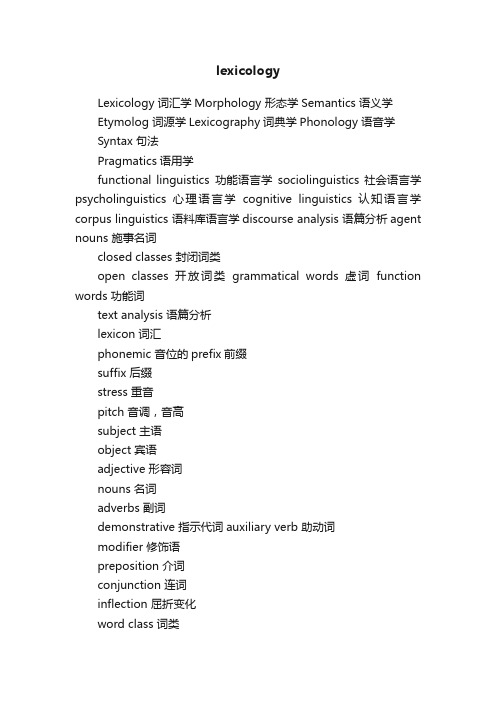
lexicologyLexicology 词汇学Morphology 形态学Semantics 语义学Etymolog 词源学Lexicography词典学Phonology 语音学Syntax 句法Pragmatics语用学functional linguistics功能语言学sociolinguistics 社会语言学psycholinguistics 心理语言学cognitive linguistics 认知语言学corpus linguistics 语料库语言学discourse analysis 语篇分析agent nouns 施事名词closed classes 封闭词类open classes 开放词类grammatical words 虚词function words 功能词text analysis 语篇分析lexicon 词汇phonemic 音位的prefix前缀suffix 后缀stress 重音pitch 音调,音高subject 主语object 宾语adjective 形容词nouns 名词adverbs 副词demonstrative 指示代词auxiliary verb 助动词modifier 修饰语preposition 介词conjunction 连词inflection 屈折变化word class 词类lexical words 实词semantic field 语义场componential analysis 成分分析semantic features 语义特征thesaurus 词库morpheme 词素lexeme 词位morph 词素变体allomorph 词素变体complex word复杂词compound word复合词bound morpheme 粘着词素free morpheme 自由词素derivational morphem派生词素inflectional morpheme屈折词素denotation外延意义reference 指称意义sense 意义conceptual meaning 概念意义connotative meaning 内涵意义social meaning 社会意义affective meaning 情感意义reflected meaning 反映意义collocative meaning 搭配意义thematic meaning 主位意义root 词根stem 词干base 词基affix 词缀bound root 粘着词根free root 自由词根polysemy 多义词homonymy 同音、形异义词writing conventions 书写规范Indo-European family 印欧语系west Germanic language西日耳曼语族celtic 凯尔特语runic 如尼文字Old English 古英语Middle English 中古英语Early Modern English现代英语早期conjunctions 连接词Kennings 代称修辞格nominative 主格accusative 对格dative 与格genitive 所有格loan translation 借译leveled inflection 屈折的磨平loss of inflection 屈折的丧失inflectional endings 屈折词尾word-formation 构词法borrowing 借词affixation 词缀法New Englishes 新英语American English 美国英语Latin alphabets 拉丁字母root creation 造新词根onomatopoeic words 拟声词ejaculation 叹词derivation 派生变化conversion 词性转换blending 溶合法back formation 逆构法shortening 缩略法proper names 专有名词metanalysis 分界变化possessive marker 所有格标记modifier 修饰语comparative 比较级superlative 最高级plural inflection 复数变化syntactic structure 句法结构third person 第三人称class-changing affixes 改变词性的词缀class-maintaining affixes 不改变词性的词缀nominalization名词化verb compounds 动词性复合词nominal compounds 名词性复合词endocentric compound向心结构exocentric compound 离心结构copulative compound 并列结构appositional compound 同位语结构shortening缩略法clipping 截短法fore clipping 首部截短法hind clipping 尾部截短法midclipping 中部截短法initialism 首字母缩略alphabetism 首字母拼写词acronym 首字母拼音词backformation 逆构法synonymy 同义词gradable antonyms 相对性反义词complementary antonyms 互补性反义词converse antonyms 逆反性反义词hyponymy 上下义词meronymy 整体-部分关系free collocation 松散搭配fixed collocation 固定搭配grammatical collocation 语法性搭配lexical collocation 词汇搭配。
英语词汇学课本与译文

Introduction 绪论0.1 The nature and Domain of English lexicology 英语词汇学的定义及研究范围Lexicology is a branch of linguistics, inquiring into the origins and meanings of words. 词汇学是语言学的一个分支,研究词汇的起源和意义。
English lexicology aims at investigating and studying the morphological structures of English words and word equivalents, their semantic structures, relations, historical development, formation and usages. 英语词汇学研究英语词汇的形态结构、词的对应及其语义结构、词义关系、词的历史演变、词的构成及词的用法等。
English lexicology is a theoretically-oriented course. 英语词汇学是一门理论性课程。
It is chiefly concerned with the basic theories of words in general and of English words in particular. 该课程主要论述词汇学的基本理论,特别是英语词汇的理论知识。
However, it is a practical course as well, for in the discussion, we shall inevitably deal with copious stocks of words and idioms, and study a great many usage examples. 但是,英语词汇学也是一门实践性课程,在该书的论述中,我们将遇到大量的词汇和习语,学习大量词汇用法实例。
修辞学与有关学科的关系
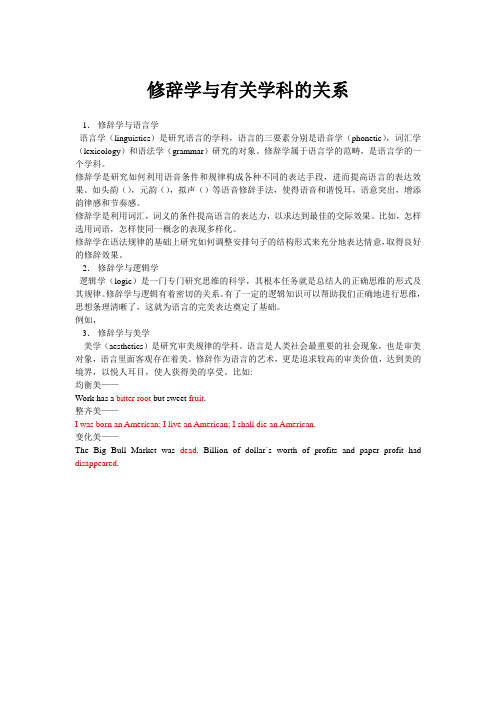
修辞学与有关学科的关系1.修辞学与语言学语言学(linguistics)是研究语言的学科,语言的三要素分别是语音学(phonetic),词汇学(lexicology)和语法学(grammar)研究的对象。
修辞学属于语言学的范畴,是语言学的一个学科。
修辞学是研究如何利用语音条件和规律构成各种不同的表达手段,进而提高语言的表达效果。
如头韵(),元韵(),拟声()等语音修辞手法,使得语音和谐悦耳,语意突出,增添韵律感和节奏感。
修辞学是利用词汇,词义的条件提高语言的表达力,以求达到最佳的交际效果。
比如,怎样选用词语,怎样使同一概念的表现多样化。
修辞学在语法规律的基础上研究如何调整安排句子的结构形式来充分地表达情意,取得良好的修辞效果。
2.修辞学与逻辑学逻辑学(logic)是一门专门研究思维的科学,其根本任务就是总结人的正确思维的形式及其规律。
修辞学与逻辑有着密切的关系。
有了一定的逻辑知识可以帮助我们正确地进行思维,思想条理清晰了,这就为语言的完美表达奠定了基础。
例如,3.修辞学与美学美学(aesthetics)是研究审美规律的学科。
语言是人类社会最重要的社会现象,也是审美对象,语言里面客观存在着美。
修辞作为语言的艺术,更是追求较高的审美价值,达到美的境界,以悦人耳目,使人获得美的享受。
比如:均衡美——Work has a bitter root but sweet fruit.整齐美——I was born an American; I live an American; I shall die an American.变化美——The Big Bull Market was dead. Billion of dollar`s worth of profits and paper profit had disappeared.。
1. Lexicology
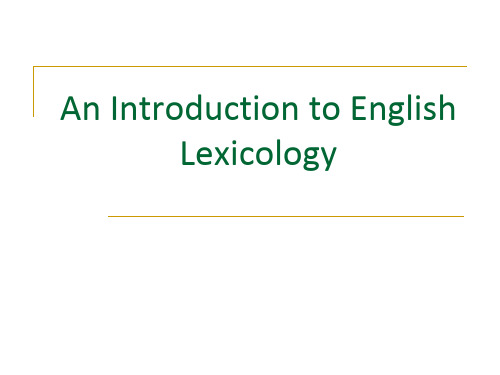
But what is language?
- Code system, linguistic rules - communicative abilities
6
English as a Tool
communication
Bridging gaps
Learning/studying How to make the tool usable/workable?
Computer language Business language Scientific language Influential language Cosmopolitan language (Esperanto) Native language First language Mother tongue Second language Foreign language Official language International language Widely-used language Common/popular language Universal/global language
a social action and a carrier of inf. a system of structure. a social phenomenon. a physiological phenomenon. a psychological phenomenon. a physical phenomenon. A system of symbols based on physiology, psychology and physics; a social action and a carrier of information used for human communication in a society. (赵世开) (rft.2/p.)
文体学Chapter 2 LexicologyPPT精品文档61页
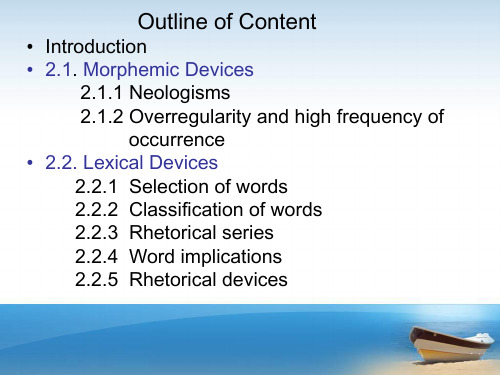
Lexicology 1. the composition of words– morphemic
devices 2. the meaning of words ---lexical devices
• 2.1 Morphemic devices
Morpheme is the smallest meaningful language unit, which cannot be devided into smaller unit without destroying or drastically altering the meaning.
---- Lexicology is concerned with the study of the meaning of words the composition of words. (Zhang Delu, 2019)
The purpose of lexicological study in relation to stylistics
• Deviation变异: linguistic features which depart from the norm or from the common core.
• Stylistic effects can be achieved by two major ways: P15
• ---by violating the existing norm, rules, principles and conventions
Introduction
Definition of Lexicology ---- Lexicology studies the choice of specific
Lexicology
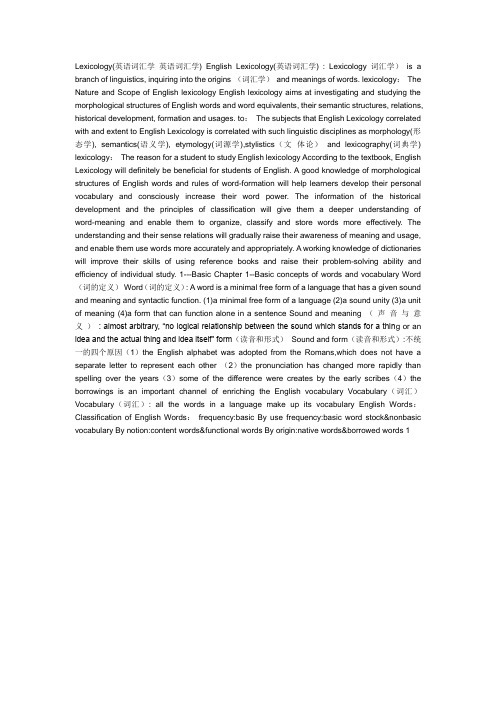
Lexicology(英语词汇学英语词汇学) English Lexicology(英语词汇学) : Lexicology 词汇学)is a branch of linguistics, inquiring into the origins (词汇学)and meanings of words. lexicology:The Nature and Scope of English lexicology English lexicology aims at investigating and studying the morphological structures of English words and word equivalents, their semantic structures, relations, historical development, formation and usages. to:The subjects that English Lexicology correlated with and extent to English Lexicology is correlated with such linguistic disciplines as morphology(形态学), semantics(语义学), etymology(词源学),stylistics(文体论)and lexicography(词典学) lexicology:The reason for a student to study English lexicology According to the textbook, English Lexicology will definitely be beneficial for students of English. A good knowledge of morphological structures of English words and rules of word-formation will help learners develop their personal vocabulary and consciously increase their word power. The information of the historical development and the principles of classification will give them a deeper understanding of word-meaning and enable them to organize, classify and store words more effectively. The understanding and their sense relations will gradually raise their awareness of meaning and usage, and enable them use words more accurately and appropriately. A working knowledge of dictionaries will improve their skills of using reference books and raise their problem-solving ability and efficiency of individual study. 1---Basic Chapter 1--Basic concepts of words and vocabulary Word (词的定义)Word(词的定义): A word is a minimal free form of a language that has a given sound and meaning and syntactic function. (1)a minimal free form of a language (2)a sound unity (3)a unit of meaning (4)a form that can function alone in a sentence Sound and meaning (声音与意义): almost arbitrary, “no logical relationship between the sound which stands for a thin g or an idea and the actual thing and idea itself” form(读音和形式)Sound and form(读音和形式):不统一的四个原因(1)the English alphabet was adopted from the Romans,which does not have a separate letter to represent each other (2)the pronunciation has changed more rapidly than spelling over the years(3)some of the difference were creates by the early scribes(4)the borrowings is an important channel of enriching the English vocabulary Vocabulary(词汇)Vocabulary(词汇): all the words in a language make up its vocabulary English Words:Classification of English Words:frequency:basic By use frequency:basic word stock&nonbasic vocabulary By notion:content words&functional words By origin:native words&borrowed words 1stock(基本词汇)The basic word stock(基本词汇): is the foundation of the vocabulary accumulated over centuries and forms the common core of the language. Though it constitute a small percentage of the EV, it is the most important part of vocabulary. Stock(基本词汇的特征) The Fundamental Features of the Basic Word Stock(基本词汇的特征): 1)All-National character(全民通用性most important)2)Stability(相对稳定性)3)Productivity(多产性)4)Polysemy(多义性)5)Collocability(可搭配性)words:(1)T erminology(术语) (2)Jargon(行话)(3)slang 没有上述特征的words: (俚语)(4)Argot(暗语)(5)Dialectal words(方言) (6) Archaisms(古语)(7) Neologisms(新词语):Neologisms means newly-created words or expressions, or words that have taken on new meanings.(email) words/notional Content words/notional words 实词(cloud, run walk, never, five, frequently) and functional words/empty words 虚词(on, of, and, be, but) words/empty 虚词( ) ) Words Native Words and Borrowed Words Nati words(本族语词)Native words(本族语词): known as Anglo-Saxon words (50,000-60,000), are words brought to Britain in the 5th century by the Germanic tribes. (mainstream of the basic word-stocks).Two other features:(1)neutral in style (2)frequent in use words/Loan words 外来语词)ords(Borrowed words/Loan words (外来语词): words taken over from foreign languages.(80% of modern EV) 4 Types of loan words: 1) denizens(同化词): (shirt from skyrta(ON)) 2) aliens(非同化词/外来词):are borrowed words which have retained their original pronunciation and spelling (kowtow (CH)磕头) 3) translation loans(译借词):按其他语言方式组成英语long time no see (from China) 4) semantic loans(借义词):they are not borrowed with reference to the form,but their meanings are borrowed Chapter 2 the development of the English Vocabulary Family(印欧语系) The Indo-European Language Family(印欧语系) IndoThe Eight Groups in Indo-European Family of Languages(8 大印欧语群)The Eastern set: (1)The Balto-slavic Group(波罗的-斯拉夫语族):Russian,Bulgarian,Polish,Czech etc. (2)The Indo-Iranian Group(印度-伊朗语族):Hindi,Bengali,Persian etc. (3)The Armenian Group(亚美尼亚语族):Armenian. (4)The Albanian Group(阿尔巴尼亚语族):Albanian. The Western set: (5)The Hellenic Group(古希腊语族):Greek. (6)The Italian Group (意大利语族):Latin ,Romance languages(French,Italian,Spanish, portuguese,Romanian) etc. (7)The Celtic Group(凯尔特语族):Irish,Welsh,Breton etc. (8)The Germanic Group(日耳曼语族):Flemish,German,Dutch,Scandinavian(Norweigian, Swedish,Danish,Icelandic) etc. 2Development Vocabulary: The Three Stages of Development of the English Vocabulary: 1 Old English (450-1100) (vocabulary 50,000 to 60,000):was I high inflected language. 2 Middle English (1150-1500):retaines much fewer inflections 3 Modern English (1500-up to now): in fact more than 25% of modern E words come almost directly from classical languages. In Modern E, words endings were mostly lost with just a few expections.English has evolved from a synthetic language(Old English) to the present analytic language. Vocabulary Development(词汇的发展模式词汇的发展模式): Modes of Vocabulary Development(词汇的发展模式): 1)creation 创造新词:the formation of new words by using the existing materials,namely toots,affixes and other elements.(最重要方式) 2)semantic change 旧词新义:does not increase the number of word forms but create many more new useages of the words. 3) borrowing 借用外来词:constitute merely 6 to 7 percent of all new words Reviving words or obsolete words also contributes to the growth of English vocabulary though quite insignificant. Chapter 3 Word Formation I Morpheme(词Morpheme(词素):the smallest functioning unit in the composition of words Allomorph(词素变体) Allomorph(词素变体): is a different variant form of a morpheme,differ in phonological and spelling form, but at the same in function and meaning Morpheme(词素的分类) Type of Morpheme(词素的分类) (1)Free Morphemes(自由词素): have complete meaning in themselves and can be used as free grammatical units in sentences. A free morpheme is one that can stand by itself. (independent). (2)Bound Morpheme(粘着语素): A bound morpheme is one that cannot stand by itself. Bound Morpheme includes two types: (1) bound root(粘附词根) (2)Affix(词缀) Affixes can be put into two groups: 1)Inflectional affixes (屈折词缀):affixes attached to the end of words to indicate grammatical relationships are inflectional,thus known as inflectional morphemes. 2)Derivational affixes(派生词缀): A) prefix: A prefix comes before words. B)suffix:An adjective suffix(形容词后缀)that is added to the stem, whatever class is belongs to , the result will be an adjective. Free Morpheme =free root (自由词根)Morpheme(词素) bound Bound root derivational affix inflectional prefix suffix stem(词根和词干)Root and stem(词根和词干)The differences between root and stem: A root is the basic form of a word which cannot be further analyzed without total loss of identity. 3A stem is the surplus part after the cutting of inflectional morpheme in a word with inflectional morphemes,can be further analyzed, it sometimes could be a root. WordII(构词法) Chapter 4 Word-Formation II(构词法) 1.Affixation 词缀法(Derivation 派生法):the formation of words by adding 1.Affixation 词缀法word-formaing or derivational affixes to stem. (1)Prefixation(前缀法):It's the formation of new words by adding a prefixes to stems. 1)Negative prefixes( 否定前缀): un-,non-,in-,dis,a- ,il-,ir-,im-,etc.disobey(not obey) 2)Reversative prefixes(逆反前缀): un-,de-,dis- etc. unwrap(open) 3) Pejorative prefixes: mis (贬义前缀):mis- ,mal-, pseudoetc.misconduct(bad behaviour) 4) Prefixes of degree or size(程度前缀):arch-,extra-,hyper-,macro-,micro-,mini-,out-,over-,sub-,super-,sur-,u ltra-,under-,ect. overweight 5) Prefixes of orientation and attitude (倾向态度前缀):contra-,counter-,anti-,pro- etc.anti-nuclear 6)Locative prefixes 方位前缀)(:extra-,fore-,inter-,intra-,tele-,trans-, etc. extraordinary(more than ordinary) 7) Prefixes of time and order(时间和顺序前缀):fore-,pre-,post-,ex-,reetc. monorail(one rail) 8) Number prefixes (数字前缀):uni-,mono-, bi-,di-, tri-,multi-,poly- ,semi-,etc.bilingual(concerning two languages) 9) Miscellaneous prefixes (混杂前缀):auto-, neo-, pan-, vice-.vice-chairman(deputy chairman) (2)Suffixation (后缀法): It's the formation of a new word by adding suffixes to stems. 1)noun suffixes 2)adjective suffixes 3)Adverb suffixes 4)verb suffixes pounding composition)pounding 复合法(also called composition)Compounding: is the formation of new words by joining two or more stems Compounds are written in three ways: solid 连写(airmail),hyphenated 带连字符(air-conditioning)and open 分开写(air force, air raid) Formation of compounds(复合词的形式)(1)noun compounds :e.g. : air + plane = airplane,flower + pot = flower pot (2)adjective compounds :e.g. acid + head = acid-head (3)verb compounds :e.g. house + keep = housekeep 3.Conversion 转类法 3.Conversion 转类法Conversion: is the formation of new words by converting words of one class to another class. 功能转换,(又叫零派生.functional shift/zero-derivation)44.Blending 拼缀法4.Blending 拼缀法Ble Blending : is the formation of new words by combining parts of two words or a word plus a part of another word. e.g: motor + hotel = motel, smoke + fog = smog, formula + translation = FORTRAN5.Clipping 5.Clipping 截短法Clipping:is to shorten a longer word by cutting a part off the original and using what remains instead.e.g. plane from airplane, phone from telephone. 四种形式:1).Front clippings 删节前面(phone from telephone) 2).Back clippings 删节后面(dorm from dormitory) 3).Front and back clippings 前后删节(flu from influenza) 4).Phrase clippings 短语删节(pop from popular music)6.Acronymy 6.Acronymy 首字母缩写法Acronymy:is the process of forming new words by joining the initial letters of names of social and political organizations or special noun phrases and technical terms. (1)Initialism (首字母缩写词法)initialisms are words pronounced letter : by letter. e.g.: BBC(for British Broadcasting corporation) (2)Acronym (首字母拼音法):Acronyms are words formed from initial letters but pronounced as a normal word. E.g.:TEFL(teaching English as a foreign language)7.Back-formation(逆生法,逆构词)7.Back-formation(逆生法,逆构词)Back Back-formation is considered to be the opposite process of suffi xation. It‟s the method of creating words by removing the supposed suffixes. (greed from greedy)8.Words Name(专有名词转成法): 8.Words From Proper Name(专有名词转成法): Names of people, places, book, and tradenames (e.g.: sir watt siemens(人名) -- watt(瓦特,电功率单位)Chapter 5 Word Meaning Meaning” The meanings of “Meaning” (“意义”的意义) Reference(所指):It is the relationship between language and the word. It Reference is the arbitrary and conventional. It is a kind of abstraction, yet with the help of context, it can refer to something specific. Concept (概念):which is beyond language, is the result of human cognition(认识),reflecting the objective world in the human mind. Sense(意义):It denotes the relationship inside the language. …The sense Sense of an expression is its place in a system of semantic relationships with 5other expressions in the language.‟ Motivation(理据):It accounts for the connection between the linguistic Motivation symbol and its meaning. 1) Onomatopoeic motivation(拟声理据):words whose sounds suggest their meaning, for these words were creates by imitating the natural sounds or noises. Knowing the sounds of the words means understanding the meaning. E.g.: bang, ping-pong, ha ha. 2)Morphological motivation (形态理据):multi-morphemic words and the meaning of many are the sum total of the morphemes combines. E.g.: airmail, miniskirt .例外:black market, ect.3)Semantic motivation (词义理据)refers to the mental associations :suggested by the conceptual meaning of a word. It explains the connection between the literal sense and figurative sense of the word. E.g:the foot of the mountain(foot) 4)Etymological motivation (词源理据):the history of the word explains the meaning of the word. E.g:pen-feather meaning(词义的类别) Types of meaning(词义的类别) 1.Grammatical Meaning(语法意义):indicates the grammatical concept or relationships (becomes important only in actual context) 2.Lexical Meaning (词汇意义)(Lexical meaning and grammatical meaning make up the word-meaning) Lexical meaning has 2 components 内容: Conceptual meaning(概念意义) and associative meaning(关联意义) 1)Conceptual meaning(概念意义): also known as denotative meaning(外延意义) is the meaning given in the dictionary and forms the core of word-meaning. 2)Associative meaning(关联意义):is the secondary meaning supplemented to the conceptual meaning. [4types: (1)Connotative(内涵意义):the overtones or associations suggested by the conceptual meaning, traditionally known as connotations.(例如“母亲”经常与“爱” “关心” “温柔”联系起来) (2)Stylistic (文体意义)many words have stylistic features, which make :them appropriate for different contexts. (3)Affective (感情意义):indicates the speaker‟s attitude towards the person or thing in question.这种情感价值观分两类:褒义和贬义appreciative & pejorative (4)Collocative(搭配意义):is the part of the word-meaning suggested by the words before or after the word in discussion.] --Sense Chapter 6 --Sense relation and semantic field (语义关系和语义场)Polysemy(多义关系)Polysemy Two approached to polysemy(多义关系的两种研究方法): 61.diachronic approach(历时方法) :from the diachronic point of view, polysemy is assumed to be the result of growth and development of the semantic structure of one and same word. First meaning is the primary meaning , the later meanings are called derived meanings.2. synchronic approach (共时方法) : synchronically, polysemy is viewed as the coexistence of various meanings of the same word in a certain historical period of time.基本意义是central meaning , 次要意义是derived meaning. Two processes of development(词义的两种发展类型): 1. radiation(辐射型):is a semantic process in which the primary meaning stands at the centre and the secondary meanings proceed out of it in every direction like rayes. (e.g: face, neck) 2. concatenation(连锁型):is the semantic process in which the meaning of a word move gradually away from its first sense by successive shifts until there is not a sign of connection between the sense that is finally developed and that which the term had at the beginning.(e.g:treacle)3. In radiation, each of the derived meaning is directly connected to the primary meaning. In concatenation, each of the later meaning is related only to the preceding one like chains. Though the latest sense can be traced back to the original, there is no direct connection in between.4. They are closely related, being different stages of the development leading to polysemy. Generally, radiation precedes concatenation. In many cases, the two processes work together, complementing each other. Homonymy (同形同音异义关系):words different in meaning but either identical both in sound and spelling or identical only in sound or spelling. homonyms(同音同形异义关系的类别) Types of homonyms(同音同形异义关系的类别) 1)Perfect homonyms(完全同音同形异义词):words identical both in sound and spelling, but different in meaning. 2)Homographs (同形异义词):words identical only in spelling, but different in sound and meaning.(最多最常见) 3)Homophones(同音异义词):words identical only in sound but different in spelling and meaning. 同形同音异义词的来源) Origins of homonyms (同形同音异义词的来源) 1)change in sound and spelling :(eare-ear, lang-long, langian-long) 2)borrowing (feria-fair, beallu-ball, baller-ball ) 3)Shortening(缩略): (ad-advertisement,) The differentiation of Homonyms from Polysemes(同音同形异义词和多义词的区别):1)The fundamental difference : Homonymy refers to different words which happen to share the same form and polysemy are the one and same word which has several distinguishable meanings. 72)One important criterion is to see their etymology(词源):Homonymys are from different sources. Polysemant is from the same source. 3)The second principle consideration is semantic relatedness(语义关联): The various meanings of polysemant are correlated and connected to one central meaning. Meanings of different homonymys have nothing to do with one another. In dictionaries, a polysemant has its meaning all listed under one headword whereas homonyms are listed as separate entries. Rhetoric features of homonyms(同形同音异义词的修辞特色):As homonyms are identical in sound or spelling, particularly homophones, they are often employed to create puns for desired effect of, say, humor, sarcasm or ridicule. Synonymy (同义关系): one of two or more words in the English language which have the same or very nearly the same essential meaning . Types of Synonymy(同义词的类别) : (1)Absolute synonyms(完全同义词):also known as complete synonyms are words which are identical in meaning in all aspects, i.e. both in grammatical meaning and lexical meaning, including conceptual and associative meanings.[ Absolute synonyms are restricted to highly specialized vocabulary in lexicology. ] (2)relative synonyms(相对同义词):also called near-synonyms are similar or nearly the same in denotation, but embrace different shades of meaning or different degrees of a given quality.(e.g: change/alter/vary, stagger/reel/totter, strange/odd/queer, idle/lazy/indolent) Sources of synonyms(同义词的来源) : 1)Borrowing (借词)最重要的来源(room-chamber, foe-enemy, help-aid, :leave-depart, wise-sage, buy-purchase) 2)Dialects and regional English (方言和地区英语)3)Figurative and euphemistic use of words (单词的修饰和委婉用法):occupation/profession-walk of life, dreamer--star-gazer, drunk-elevated, lie-distort of fact.4)Coincidence with idiomatic expressions(与习惯表达一致):win-gain the upper hand, decide-make up one‟s mind, finish-get through, hesitate-be in two minds, help-lend one a hand. Discrimination of Synonyms (1)difference in denotation 外延不同. Synonyms may differ in the range and intensity of meaning.(rich-wealthy, work-toil, want-wish-desire) (2)difference in connotation 内涵不同 . By connotation we mean the stylistic and emotive colouring of words. Some words share the same denotation but differ in their stylistic appropriateness. ( 借词:answer-respond, storm-tempest, wood-forest, handy-manual, unlike-dissimilar, homely-domestic, fleshy-carnal. 中性词:8policeman-constable-bobby-cop, ask-beg-request. 古语词、诗歌:ire/anger, bliss-happiness, forlorn-distresses, dire-dreadful, list-listen, enow-enough, save-expect, mere-lake ) (3)difference in application. Many words are synonymous in meaning but difference in usage in simple terms. They form different collocations and fit into difference sentence patterns. (allow sb. to do sth.- let sb. do sth. / answer the letter-reply to the letter) Antonymy (反义关系) :it is concerned with semantic opposition. Antonyms can be defined as words which are opposite in meaning. Types of Antonyms: 1)contradictory terms ( 矛盾反义词): these antonyms truly represent oppositeness of meaning. 特点:①The assertion of one is the denial of the other. ②Such antonyms are non-gradable. They cannot be used in comparative degrees and do not allow adverbs of intensity like “very” to qualify them . (e.g: single/married) 2)contrary terms(对立反义词): antonyms of this type are best viewed in terms of a scale running between two poles or extremes.(e.g: old/young, rich/young, big/small) The two opposites are gradable and one exists in comparison with the other.3)relative terms (关系反义词)this type consists of relational opposites. :(parent/child, husband/wife, employee/employer, sell/buy, receive-give)antonyms(反义关系的特点): Some of the characteristics of antonyms(反义关系的特点): 1)antonyms are classified on the basis of semantic opposition(语义对立) 2)a word which has more than one meaning can have more than one antonym 3)antonyms differ in semantic inclusion(语义内涵)4)contrary terms are gradable antonyms,differing in degree of intensity, so each has its own corresponding opposite.(hot/warm: hot-cold/warm-cool) antonyms(反义词的使用)The use of antonyms(反义词的使用)1)Antonyms are helpful and valuable in defining the meaning of words. 2)To express economically the opposite of a particular thought for the sake of contrast.(e.g :now or never, rain or shine, friend or foe 敌友,weal and woe 哀乐) 3)To form antithesis(对比法) to achieve emphasis by putting contrasting idea together. (proverbs and sayings: easy come , easy go./ more haste, less speed.) Hyponymy(上下义关系): Hyponymy deals with the relationship of semantic Hyponymy inclusion. The meaning of a more specific word is included in that of another more general word. For example, a cat is hyponym of animal Superordinate and Subordinate (上义词和下义词):use subordinates which are concrete and precise ,presenting a vivid verbal picture before the reader. Superordinates which convey only a general and vague idea. 9Field(语义场) Semantic Field(语义场) Viewing the total meaning in this way is the basis of field theory. e.g.(apple, pear, peach, date, mango, orange, lemon, etc. make up the semantic field of …fruits‟) The semantic field of the same concept may not have the same members in different language. e.g.(aunt in English, may means “父亲的姐姐,妈妈的姐姐,父亲哥哥的妻子” in Chinese.(122) Chapter 7 Changes in Word Meaning 词义的演变Vocabulary is the most unstable element of a language as it is undergoing constant changes both in form and content. Comparatively the content is even more unstable than the form. Changes 词义变化的种类) Types of Changes (词义变化的种类) 1.Extension generalization( 1.Extension /generalization( 词义的扩大): is the name given to the widening of meaning which some words undergo. It is a process by which originally had a specialized meaning has now become generalized.(e.g: manuscript, fabulous, picture, mill, journal, bonfire, butcher, companion) 2.Narrowing specialization( 词义的缩小) Narrowing/ 2.Narrowing/ specialization( 词义的缩小) :is the opposite of widening meaning. It is a process by which a word of wide meaning acquires a narrower or specialized sense. In other words, a word which used to have a more general sense becomes restricted in its application and conveys a special meaning in present-day English.(e.g: deer, corn, garage, liquor, meat, disease, poison, wife, accident, girl). [ when a common word is turned into a proper noun, the meaning is narrowed accordingly. ] 3.Elevation amelioration( 升华) 3.Elevation /amelioration( 词义的升华):refers to the process by which words rise from humble(粗陋的)beginnings to positions of importance. [nice, marshal, constable, angel, knight, earl, governor, fond, minister, chamberlain ] 4.Degradation pejoration(词义的降格Degrada 降格) 4.Degradation / pejoration(词义的降格):A process whereby words of good origin fall into ill reputation or non-affective words come to used in derogatory(贬损的)sense.[boor, churl, wench, hussy, villain, silly, knave, lewd, criticize, lust ] 5.Transfer 词义的转移) Transfer( 5.Transfer(词义的转移): Words which were used to designate 指明one thing but later changed to mean something else have experienced the process of semantic transfer. Semantic Change(词义变化的原因) Causes of Semantic Change(词义变化的原因) 1.Extra Extrafactors(词义演变的语言外部因素) 1.Extra-linguistic factors(词义演变的语言外部因素): 1) Historical reason( 历史原因) :Increased scientific knowledge and 10discovery, objects, institutions, ideas change in the course of time. E.g: pen, car, computer. 2 )Class reason(阶级原因):The attitude of classes have also made inroads into lexical meaning in the case of elevation or degradation. 3) Psychological reason(心理原因):the associated transfer of meaning and euphemistic use of words are often due to psychological factors. Such slow, humble and despised occupations take more appealing names is all due to psychological reasons. 2.Linguistic factors(语言内部原因):the change of meaning may be caused 2.Linguistic factors(语言内部原因)by internal factors with in the language system. 1)shorting 缩略:gold-gold medal, gas-coal gas, bulb-light bulb, private-private soldier 2)borrowing 借用:deer-animal-beast 3)analogy 类推: 词义和语境Chapter 8 Meaning and Context 词义和语境Context in its traditional sense refers to the lexical items that precede or follow a given word. Modern linguists have broadened its scope to include both linguistic and extra-linguistic contexts. context(语境的种类)Two types of context(语境的种类)Extracontext/ Nonsituation(非语言语境):In 1. Extra-linguistic context/ Non-linguistic situation(非语言语境)a broad sense, context includes the physical situation as well, which embraces the people, time, place, and even the whole cultural background. (look out, weekend, landlord ) 2.Linguistic context/ grammatical context context(语言语境):In a narrow sense, Linguistic context/ it refers to the words, clauses, sentences in which a word appears. It may cover a paragraph, a whole chapter and even the entire book.分为两类:1) Lexical context(词汇语境):It refers to the word that occurs together with the word in question. (e.g: paper, do) 2) Grammatical context (语法语境)It refers the situation when the meaning :of a word may be influenced by the structure in which it occurs. (e.g: become) context(语境的作用) The role of context(语境的作用) 1.Eliminat Elimination ambiguity 消除歧义) 1.Elimination of ambiguity(消除歧义) 1)Ambiguity due to polysemy or homonymy. 2)Grammatical structure can also lead to ambiguity 如何消除歧义?——①extend the original sentence ②alter the context a little 2.Indicat Indication referents 限定所指) 2.Indication of referents(限定所指) 如何限定所指?——①with clear context ②with adequate verbal context 3.Provision word提供线索以猜测词义) 3.Provision of clues for inferring word-meaning (提供线索以猜测词义) 111)definition 2)explanation 3)example 4)synonymy 5)antonymy 6)hyponymy(上下义关系)7)relevant details 8)word structure English Chapter 9 English Idioms 英语习语dioms(习语的定义)Idioms(习语的定义): are expressions that are not readily understandable from their literal meaning of individual elements. In a broad sense, idiom may include colloquialisms (俗语)Catchphrases , (标语),slang expressions (俚语),proverbs(谚语),etc. They form an important part of the English vocabulary. Idioms(英语习语的特点)Characteristics of Idioms(英语习语的特点)1.Semantic 语意的整体性)1.Semantic unity (语意的整体性)words in the idiom they have lost their :individual identity. Their meanings are not often recognizable in the meaning of the whole idiom. The semantic unity of idioms is also reflected in the illogical relationship between the literal meaning of each of the idiom. 2.Structural stability(结构的稳定性) 2.Structural stability(结构的稳定性):the structure of an idiom is to a large extent un changeable. 1) the constituents of idioms cannot be replaced 2) the word order cannot be inverted or changed 3) the constituents of idioms cannot be deleted or added to, not even an article. 4) many idioms are grammatically unchangeable The fixity of idiom depends on the idiomaticity.习语性表达习惯Idioms(英语习语的分类)Classification of Idioms(英语习语的分类) 1. idioms nominal in nature 名词性习语(white elephant 累赘物) 2 .idioms adjectival in nature 形容词性习语(as poor as a church mouse)3 .idioms verbal in nature 动词性习语(look into)4 .idioms adverbial in nature 副词性习语(tooth and nail 拼命)5 .sentence idioms 句式习语(never do things by halves)idioms(习语的使用)Use of idioms 1.Stylistic features(文体色彩):Stylistic features(文体色彩)1)colloquialisms(俗语)2)slang (俚语)3)literary expressions(书面表达)12The same idiom may show stylistic differences when it is assigned(指派)different meanings.2.Rhetorical features(修辞色彩) 2.Rhetorical features(修辞色彩) 1) phonetic manipulation (语音处理):(1)alliteration 头韵法(2)rhyme 尾韵法2)lexical manipulation(词法处理)(1)reiteration(duplication of synonyms)同义词并举[scream and shout] (2)repetition 重复[out and out] (3)juxtaposition (of antonyms) 反义词并置[here and there]3.figures speech(修辞格)3.figures of speech(修辞格)(1)simile 明喻(2)metaphor 暗喻(3)metonymy 换喻/以名词代动作:live by one‟s pen (4)synecdoche 提喻/以部分代整体:earn one‟s bread (5)Personification 拟人法(6)Euphemism 委婉语:kick the bucket(die) (7)hyperbole 夸张:a world of trouble idioms(习语的变异形式) Variations of idioms(习语的变异形式): 1.addition 增加2.deletion 删除 3.replacement 替换4.position-shifting 位置转移5.dismembering 分解Chapter 10 English Dictionaries 英语字典Dictionary: Dictionary presents in alphabetical order the words of English, with information as to their spelling ,pronunciation, meaning, usage , rules and grammar, and in some, their etymology(语源). dictionaries(词典的种类) Types of dictionaries(词典的种类): 1.Monolingual dictionaries(单语词典和双语词典):最早的词1.Monolingual & bilingual dictionaries (单语词典和双语词典)最早的词:典都是双语的(1).Monolingual dictionary: is written in one language (LDCE, CCELD). The headword or entries are defined and illustrated in the same language. (2).Bilingual dictionary: involve two languages (A New English-Chinese D, A Chinese-English D) 2.Linguistic dictionaries(语文词典与百科词典)2.Linguistic and Encyclopedic dictionaries(语文词典与百科词典)(1)Linguistic dictionary: aim at defining words and explaining their usages in the language (spelling, pronunciation, meaning, grammatical, 13。
英语词汇学chapter 1 Lexicology

With stylistics: Leech defines stylistics as the study of the use of language in literature and considers stylistics a meeting ground of linguistics and literary study. To put it here concerning lexicology, Stylistics is the study of optional variations in the sounds, forms, or vocabulary of a language, different situations of use, or different literary types.
Lexicology
The
first semester of 2013-2014
Chapter one the definition of lexicology
1.1 Lexicology
The term lexicology contains two Greek morphemes: lexicon and logie. The former means word and the latter means learning or the study of. The literal meaning of the term is the science of words
Chapter one the definition of lexicology
Students will use the basic knowledge of English lexicology to understand the material already familiar to them from English classes and apply it in their further study of English.
Lexicology
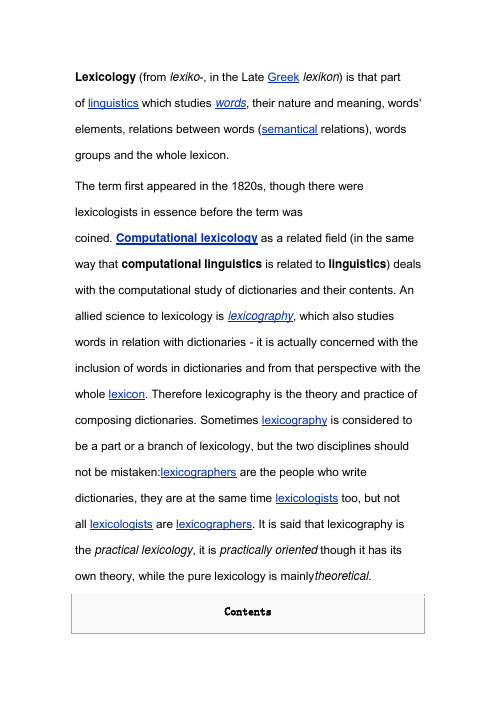
Lexicology (from lexiko-, in the Late Greek lexikon) is that partof linguistics which studies words, their nature and meaning, words' elements, relations between words (semantical relations), words groups and the whole lexicon.The term first appeared in the 1820s, though there were lexicologists in essence before the term wascoined. Computational lexicology as a related field (in the same way that computational linguistics is related to linguistics) deals with the computational study of dictionaries and their contents. An allied science to lexicology is lexicography, which also studies words in relation with dictionaries - it is actually concerned with the inclusion of words in dictionaries and from that perspective with the whole lexicon. Therefore lexicography is the theory and practice of composing dictionaries. Sometimes lexicography is considered to be a part or a branch of lexicology, but the two disciplines should not be mistaken:lexicographers are the people who write dictionaries, they are at the same time lexicologists too, but notall lexicologists are lexicographers. It is said that lexicography is the practical lexicology, it is practically oriented though it has its own theory, while the pure lexicology is mainly theoretical.[hide]1 Lexical semanticso 1.1 Domaino 1.2 History▪ 1.2.1 Prestructuralist semantics▪ 1.2.2 Structuralist and neostructuralist semantics▪ 1.2.3 Chomskyan school▪ 1.2.4 Cognitive semantics2 Phraseology3 Etymology4 Lexicographyo 4.1 Noted lexicographers5 Lexicologists6 Bibliography7 References8 See also9 External linkso9.1 Societieso9.2 Theory[edit]Lexical semanticsMain article: Semantics[edit]DomainSemantical relations between words are manifested in respectof homonymy, antonymy, paronymy, etc. Semantics usually involved in lexicological work is called lexical semantics. Lexical semantics is somewhat different from other linguistic types of semantics like phrase semantics, semantics of sentence, and text semantics, as they take the notion of meaning in much broader sense. There are outside (although sometimes related to) linguistics types of semantics like cultural semantics and computational semantics, as the latest is not relatedto computational lexicology but to mathematical logic. Among semantics of language, lexical semantics is most robust, and to some extend the phrase semantics too, while other types of linguistic semantics are new and not quite examined.[edit]HistoryLexical semantics may not be understood without a brief exploration of its history.[edit]Prestructuralist semanticsSemantics as a linguistic discipline has its beginning in the middle of the 19th century, and because linguistics at the time was predominantly diachronic, thus lexical semantics was diachronic too - it dominated the scene between the years of 1870 and 1930.[1] Diachronic lexical semantics was interested without a doubt in the change of meaning withpredominantly semasiological approach, taking the notion of meaning in a psychological aspect: lexical meanings were considered to be psychological entities), thoughts and ideas, and meaning changes are explained as resulting from psychological processes.[edit]Structuralist and neostructuralist semanticsWith the rise of new ideas after the ground break of Saussure's work, prestructuralist diachronic semantics was considerably criticized for the atomic study of words, the diachronic approach and the mingle of nonlinguistics spheres of investigation. The study became synchronic, concerned with semantic structures and narrowly linguistic.Semantic structural relations of lexical entities can be seen in three ways:▪semantic similarity▪lexical relations such as synonymy, antonymy, and hyponymy▪syntagmatic lexical relations were identifiedAs structuralist lexical semantics was revived by neostructuralist not much work was done by them, it is actually admitted by the followers.It may be seen that WordNet "is a type of an online electronic lexical database organized on relational principles, which now comprises nearly 100,000 concepts" as Dirk Geeraerts[2] states it. [edit]Chomskyan schoolMain article: Generative semanticsFollowers of Chomskyan generative approach to grammar soon investigated two different types of semantics, which, unfortunately, clashed in an effusive debate[3], these were interpretativeand generative semantics.[edit]Cognitive semanticsMain article: Cognitive semanticsCognitive lexical semantics is thought to be most productive of the current approaches.[edit]PhraseologyMain article: PhraseologyAnother branch of lexicology, together with lexicographyis phraseology. It studies compound meanings of two or more words, as in "raining cats and dogs". Because the whole meaning of that phrase is much different from the meaning of words included alone, phraseology examines how and why such meanings come in everyday use, and what possibly are the laws governing these word combinations. Phraseology also investigates idioms.[edit]EtymologyMain article: EtymologySince lexicology studies the meaning of words and their semantic relations, it often explores the origin and history of a word, i.e. its etymology. Etymologists analyse related languages using a technique known as the comparative method. In this way, word roots have been found that can be traced all the way back to the origin of, for instance, the Indo-European language family. However, the comparative method is unhelpful in the case of "multiplecausation"[4], when a word derives from several sources simultaneously as in phono-semantic matching.[5]Etymology can be helpful in clarifying some questionable meanings, spellings, etc., and is also used in lexicography. For example, etymological dictionaries provide words with their historical origins, change and development.[edit]LexicographyMain article: LexicographyA good example of lexicology at work, that everyone is familiar with, is that of dictionaries and thesaurus. Dictionaries are books or computer programs (or databases) that actually represent lexicographical work, they are opened and purposed for the use of public.As there are many different types of dictionaries, there are many different types of lexicographers.Questions that lexicographers are concerned with are for example the difficulties in defining what simple words such as 'the' mean, and how compound or complex words, or words with many meanings can be clearly explained. Also which words to keep in and which not to include in a dictionary.[edit]Noted lexicographersMain article: LexicographerSome noted lexicographers include:▪Dr. Samuel Johnson (September 18, 1709 – December 13, 1784)▪French lexicographer Pierre Larousse (October 23, 1817-January 3, 1875)▪Noah Webster (October 16, 1758 – May 28, 1843)▪Russian lexicographer Vladimir Dal (November 10, 1801 –September 22, 1872)[edit]Lexicologists▪Damaso Alonso, (Oct. 22, 1898-) Spanish literary critic and lexicologist▪Roland Barthes, (Nov. 12, 1915-Mar. 25, 1980) French writer, critic and lexicologist[edit]Bibliography▪Lexicology/Lexikologie: International Handbook on the Nature and Structure of Words and Vocabulary/EinInternationales Handbuch Zur Natur and Struktur Von Wortern Und Wortschatzen, Vol 1. & Vol 2. (Eds. A. Cruse et al.)▪Words, Meaning, and Vocabulary: An Introduction to Modern English Lexicology, (ed. H. Jackson); ISBN 0-304-70396-6▪Toward a Functional Lexicology, (ed. G. Wotjak); ISBN 0-8204-3526-0▪Lexicology, Semantics, and Lexicography, (ed. J.Coleman); ISBN 1-55619-972-4▪English Lexicology: Lexical Structure, Word Semantics & Word-formation,(Leonhard Lipka.); ISBN 9783823349952▪Outline of English Lexicology , (Leonhard Lipka.); ISBN 3484410035[edit]References1. ^ Dirk Geeraerts, The theoretical and descriptivedevelopment of lexical semantics, Prestructuralist semantics, Published in: The Lexicon in Focus. Competition andConvergence in Current Lexicology, ed. Leila Behrens andDietmar Zaefferer, p. 23-422. ^ Dirk Geeraerts, The theoretical and descriptivedevelopment of lexical semantics, Structuralist andneostructuralist semantics, Published in: The Lexicon inFocus. Competition and Convergence in Current Lexicology, ed. Leila Behrens and Dietmar Zaefferer, p. 23-423. ^ Harris, Randy Allen (1993) The Linguistics Wars, Oxford,New York: Oxford University Press4. ^ Zuckermann, Ghil'ad (2009), Hybridity versusRevivability: Multiple Causation, Forms andPatterns, Journal of Language Contact, Varia 2: 40-67.5. ^ Zuckermann, Ghil'ad (2003), ‘‘Language Contact andLexical Enrichment in Israeli Hebrew’’, Houndmills: Palgrave Macmillan, (Palgrave Studies in Language History andLanguage Change, Series editor: Charles Jones). ISBN1-4039-1723-X.。
Lexicology
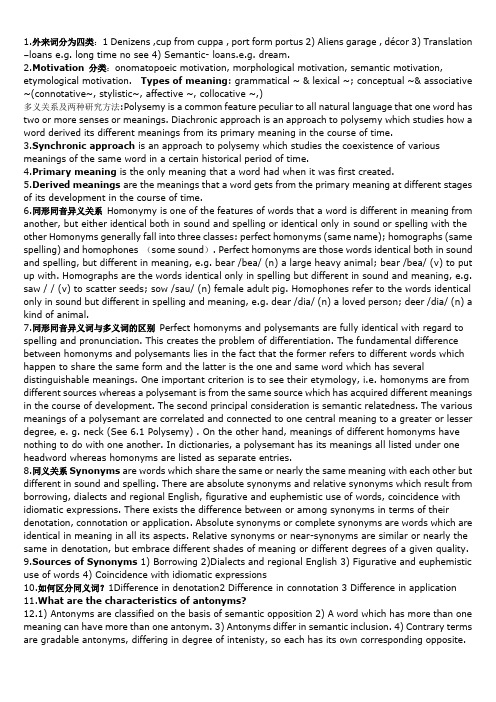
1.外来词分为四类:1 Denizens ,cup from cuppa , port form portus 2) Aliens garage , décor 3) Translation –loans e.g. long time no see 4) Semantic- loans.e.g. dream.2.Motivation 分类:onomatopoeic motivation, morphological motivation, semantic motivation, etymological motivation. Types of meaning: grammatical ~ & lex ical ~; conceptual ~& associative ~(connotative~, stylistic~, affective ~, collocative ~,)多义关系及两种研究方法:Polysemy is a common feature peculiar to all natural language that one word has two or more senses or meanings. Diachronic approach is an approach to polysemy which studies how a word derived its different meanings from its primary meaning in the course of time.3.Synchronic approach is an approach to polysemy which studies the coexistence of various meanings of the same word in a certain historical period of time.4.Primary meaning is the only meaning that a word had when it was first created.5.Derived meanings are the meanings that a word gets from the primary meaning at different stages of its development in the course of time.6.同形同音异义关系Homonymy is one of the features of words that a word is different in meaning from another, but either identical both in sound and spelling or identical only in sound or spelling with the other Homonyms generally fall into three classes: perfect homonyms (same name); homographs (same spelling) and homophones (some sound). Perfect homonyms are those words identical both in sound and spelling, but different in meaning, e.g. bear /bea/ (n) a large heavy animal; bear /bea/ (v) to put up with. Homographs are the words identical only in spelling but different in sound and meaning, e.g. saw / / (v) to scatter seeds; sow /sau/ (n) female adult pig. Homophones refer to the words identical only in sound but different in spelling and meaning, e.g. dear /dia/ (n) a loved person; deer /dia/ (n) a kind of animal.7.同形同音异义词与多义词的区别Perfect homonyms and polysemants are fully identical with regard to spelling and pronunciation. This creates the problem of differentiation. The fundamental differen ce between homonyms and polysemants lies in the fact that the former refers to different words which happen to share the same form and the latter is the one and same word which has several distinguishable meanings. One important criterion is to see their etymology, i.e. homonyms are from different sources whereas a polysemant is from the same source which has acquired different meanings in the course of development. The second principal consideration is semantic relatedness. The various meanings of a polysemant are correlated and connected to one central meaning to a greater or lesser degree, e. g. neck (See 6.1 Polysemy) . On the other hand, meanings of different homonyms have nothing to do with one another. In dictionaries, a polysemant has its meanings all listed under one headword whereas homonyms are listed as separate entries.8.同义关系Synonyms are words which share the same or nearly the same meaning with each other but different in sound and spelling. There are absolute synonyms and relative synonyms which result from borrowing, dialects and regional English, figurative and euphemistic use of words, coincidence with idiomatic expressions. There exists the difference between or among synonyms in terms of their denotation, connotation or application. Absolute synonyms or complete synonyms are words which are identical in meaning in all its aspects. Relative synonyms or near-synonyms are similar or nearly the same in denotation, but embrace different shades of meaning or different degrees of a given quality.9.Sources of Synonyms 1) Borrowing 2)Dialects and regional English 3) Figurative and euphemistic use of words 4) Coincidence with idiomatic expressions10.如何区分同义词?1Difference in denotation2 Difference in connotation 3 Difference in application11.What are the characteristics of antonyms?12.1) Antonyms are classified on the basis of semantic opposition 2) A word which has more than one meaning can have more than one antonym. 3) Antonyms differ in semantic inclusion. 4) Contrary terms are gradable antonyms, differing in degree of intenisty, so each has its own corresponding opposite.13.上下义关系:Hyponymy deals with the relationship of semantic inclusion. That is, the meaning of a more specific word is included in that of another more general word. Superordinates refer to so me general words; subordinates denote those more specific words. Hyponymy can be described in terms of tree-like graphs, with higher-order superordinates above the lower subordinates. But their status either as superordinate or subordinate is relative to other terms. For example, horse, dog, pig are subordinates in relation to animal, but superordinates of mare, hound and boar, Animal itself becomesa subordinate of creature. And creature in turn becomes14.词义变化的种类There are five types of meaning, changes: extension, narrowing, degradation, elevation, and transfer among which extension and narrowing are the most common. Changes i n meaning can be accounted for from extra-linguistic factors (historical reason, class reason, and psychological reason) and intra-linguistic factors (shortening, the influx of borrowing, and analogy).15.词义的扩大Extension is a process by which a word with a specialized sense is generalized to cover a broader or less16.definite concept. Compare the following;词义的缩小Narrowing is a process by which a word of wider meaning acquires a specialized sense;词义的升华Elevation is a process by which a word moves from a derogatory or neutral sense to a neutral and/or appreciative sense;词义的降格Degradation is a process by which a word of reputation slides into a pejorative use,;词义的转移Transfer is a process by which a word denoting one thing changes to refer to a different but related thing. Paper serves as an example. This word formerly denoted an African plant papyrus, which was once used to make paper. In modern times, paper is made from rags, wood, straw and the like, but the product has retained the same name. There is associated transfer. There are other kinds of transfer, such as, concrete to abstract, abstract to concrete and transfer of sensation.17.语境的种类:非语言语境。
英语词汇学 Unit_01 Introduction to lexicology
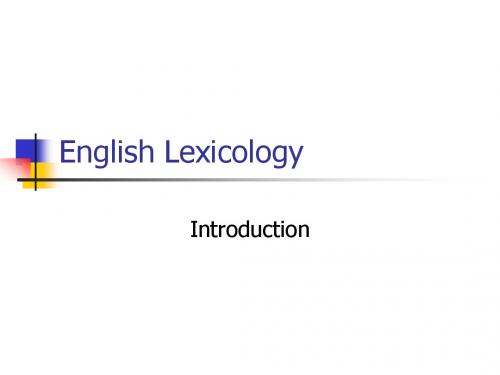
nonbasic vocabulary : terminology(专业术语), jargon 行 话 ), slang,( 俚 语 )argot( 黑 话 ), dialectal(方言) terminology: photoscanning(扫描), penicillin (盘尼西林), algebra(代数 ) jargon : bottom line ( 必 然 结 果 ) , bargaining chip谈判各方的优势 slang : grass and pot(毒品大麻), smoky, bear (police),X- rays (radar ) argot : can-opener (all-purpose key), dip (pick-pocket ) dialectal : auld (Scot=old), coo (Scot= cow)
lexicology
0. INTRODUCTION
What is lexicology?
What is a word?
What does it mean to know a word?
How many words are there in English?
How many of these words do I know?
e.g. dog, desk, chair
e.g. meet, meat, mete Knight, night
A word is a symbol that stands out for sth else in the world.
no logical relationship, different languages ,same concept , the same phonological form may convey different meaning :
1.LexicologyWords&Vocabulary
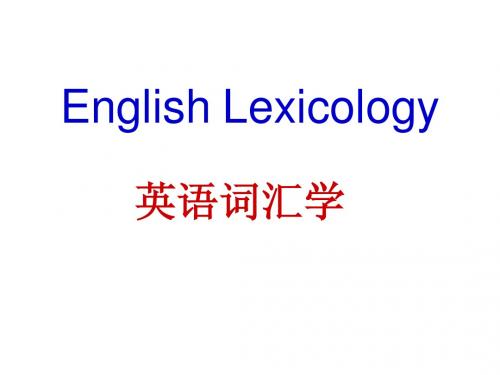
Examples of disagreement between sound and spelling
• • • • • Plough Cough Comb Have Cave
Reasons for Sound-form Disagreement
• The internal reason that the English alphabet was adopted from Latin. • Pronunciation changed more rapidly than spelling. • Early scribes(抄写员) created some differences. • In the late 1500, printing helped to freeze spelling. • Borrowing of words.
Compare the following pairs:
• • • • • Condemn, condemnation , bombard Hymn, hymnal Resign, resignation Paradigm, paradigmatic
Word and Vocabulary
• What evidence is given in the text to prove that the sound-meaning relationship of words is arbitrary?
P8
Sound and Form (spelling)
声音与形式
• The written form of a natural language is the written record of the oral form. • The written form should agree with the oral form. • But in fact English spelling is often an imperfect representation of the spoken form.
文体学Chapter 2 Lexicology 共61页
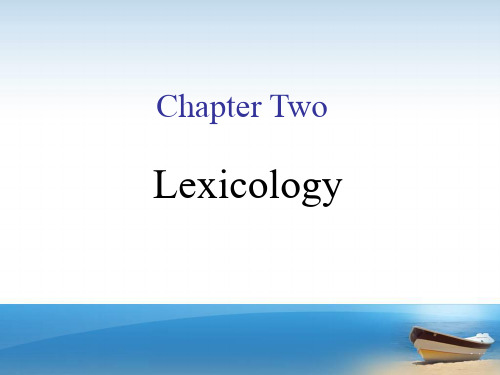
• ---making a certain morpheme occur in unexpected high frequency
• 2.1.1 Neologism
• Neologisms are newly-created words or expressions, or words that have taken on new meanings.
• "Power corrupts, and absolute power corrupts absolutely. "
• Lord Acton
• "Not as a call to battle, though embattled we are."
• John F. Kennedy
• T.S. Eliot’s poem “The Dry Salvages” (1941)
(G.M.Hopkins, The Wreck of the Deutschland) P16
Compounding: white-fiery (white and fiery have parallel relation, meaning white and fiery) whirlwind-swivelled (have relations of agents and actions, i.e. swivelled by whirlwind) widow-making (make and widow are in the relation of process and goal, i.e. to make widows)
Lexicology复习要点

Lexicology复习要点Linguistics: Generally speaking, linguistics can be defined as the scientific study of language. To be more exact, linguistics studies the general principles upon which languages are constructed and operate as systems of human communicationLanguage: Language is a system of arbitrary vocal symbols used for human communication. It is a specific social action and a carrier of information.Lexicology: Lexicology is a branch of linguistics concerned with the study of the vocabulary of a given language. It deals with words, their origin, development, structure, formation, meaning and usage.1. Definition of Word:Word: A word is a minimal free form of a language that has given sound and meaning and syntactic function.A word comprises the following points:(1) a minimal free form of a language(2) a sound unity(3) a unit of meaning(4) a form that can function alone in a sentence2. Sound and meaning:The symbolic connection between sound and meaning is almost always arbitrary.3. Vocabulary:All the words in a language make up its vocabulary.4. Classification of words:Words fall into the basic words and nonbasic vocabulary by use frequency, into content words and functional words by notion, and into native words and borrowed words by origin.By notion, words can be grouped into content words and functional words. content words denote clear notions and thus are known as notional words. they include nouns, verbs, adjectives, adverbs and numerals, which denote objects, phenomena, action, quality, state, degree, quantity, etc.Functional words do not have notions of their own. Therefore, they are also called empty words. as their chief function is to express the relation between notions, the relation between words as well as between sentences, they are known as form words.5. Development of English vocabulary:Old English (450 ~ 1150):Celtic --- Latin of the Roman Legions --- Anglo-Saxon of the Germantic tribes (now people generally refer to Anglo-Saxon as old English) --- religious terms brought by the introduction of Christianity (6th century) --- Scandinavian words of Norwegian and Danish vikings (the 9th century)Middle English: French of Norman (1066) --- English came back (13th century)Modern English: Early Modern English (1500 ~ 1700): Latin and Greek were borrowed in the time of RenaissanceLate Modern English (after 1700): absorbing words from all major languages of the world with the growth of colonization. (Mid-seventeenth) --- new words created about science and technology (after World War II)6. Characteristics of English:Old English: Old English was a highly inflected language, language of full endings.Middle English: Language of leveled endings.Modern English:English has envolved from a synthetic language (Old English) to the present analytic language.8. Causes of the development:Generally, there are three main sources of new words: the rapid development of modern science and technology; social, economic and political changes; the influence of other cultures and languages.9. Morpheme:The morpheme is “the smallest functioning unit in the composition of words”. Morphemes are the minimal meaningful units.10. Allomorph:Morphemes are abstract units, which are realized in speech by discreet units known as morphs.Most morphemes are realized by single morphs and they coincide with words as they can stand by themselves and function freely in a sentence. Words of this kind are called monomorphemic words.An allomorph is any of the variant forms of a morpheme as conditioned by position or adjoining sounds.11. Classification of morphemes:Free morpheme: Morphemes which are independent of other morphemes are considered to be free. These morphemes have complete meanings in themselves and can be used as free grammatical units in sentences.Free morphemes are free roots.Bound morpheme: Morphemes which cannot occur as separate words bound. They are so named because they are bound to other morphemes to form words.Bound morphemes are chiefly found in derived words.12. Root and affixRoot:A root is the basic unchangeable part of a word, and it conveys the main lexical meaning of the word.Free root: free roots can stand alone as words and provide the language with a basis for the formation of new words.Bound roots(粘着词根): A bound root is that part of the word that carries the fundamental meaning just like a free root. Unlike a free root, it is a bound form and has to combine with other morphemes to make words.A root is the basic form of a word which cannot be further analyzed without total loss for identity. In terms of derivational and inflectional morphology, a “root is that part of a word form that remains when all inflectional and derivational affixes have been removed.”A stem can be defined as a form to which affixes of any kind can be added.Affixes(词缀): Affixes are forms that are attached to words or word elements to modify meaning or function. According to the functions of affixes, we can put them into two groups: inflectional and derivational affixes.Inflectional affix (inflectional morpheme):An inflectional affix serves to express such meanings as plurality, tense, and the comparative or superlative degree. It does not form a new word with new lexical meaning when it is added to another word.Derivational affix (derivational morpheme): it is so called because when it is added to another morpheme, it “derivates” a new word. Many derivational affixes have a specific lexical meaning.The most productive word-formations are affixation, compounding and conversion.13. Derivation:Derivation:Derivation or affixation is generally defined as a word-formation process by which new words are created by adding a prefix, or suffix, or both, to the base.Prefixation: Prefixation is the formation of new words by adding a prefix or combing form to the base. Prefixes modify the lexical meaning of the base.(1) Negative prefixes: a-, dis-, in- (il-, ir-, im-), non-, un-(2) Reversative prefixes: de-, dis-, un-(3) Pejorative prefixes: mal-, mis-, pseudo-(4) Prefixes of degree or size: arch-, extra-, hyper-, macro-, micro-, mini-, out-, over-, sub-, super, sur-, ultra-, under-(5) Prefixes of orientation and attitude: anti-, contra-, counter-, pro-(6) Locative prefixes: extra-, fore-, inter-, intra-, tele-, trans-(7) Prefixes of time and order: ex-, fore-, post-, pre-, re-(8) Number prefixes: bi-, multi- (poly-), semi- (hemi-), tri-, uni- (mono-)(9) Miscellaneous prefixes: auto-, neo-, pan-, vice-Suffixation:Suffixation is the formation of a new word by adding a suffix or a combing form to the base, and usually changing the word-class of the base.Suffixes have only a small semantic role, their primary function being to change the grammatical function of stems. In other words, they mainly change the word class.(1) Noun suffixes:A. Denominal nouns:Concrete: The suffixes of this group are added to noun bases to produce concrete nouns: -eer, -er, -ette, -let, e.g. profiteer (person who makes unfairly large profits).Abstract: The following suffixes come at them end of noun stems to form abstract nouns: -age, -dom, -ery, -hood, -ing, -ism, -ship, e.g. wastage, mileage, officialdom (officials as a group)B. Deverbal nouns:The following suffixes combine with verb stems to create largely nouns denoting people: -ant, -ee, -ent, -er (-or), e.g. assistant, informant (one who gives information to police, etc.) Suffixes of this group added to verb stems to produce largely abstract nouns, denoting action, result, process, state, etc.: -age, -al, -ance, -ation (-ition, -tion, -sion, -ion), ence, -ing, -ment, e.g. linkage, carriage.C. De-adjective nouns: -ity, -ness, e.g. popularity, productivity, happiness, largenessD. Noun and adjective suffixes:A small number of suffixes, when added to stems related to human beings or nationality names, form words that can be both as nouns and adjectives: -ese, -an, - ist, e.g. Lebanese, Chinese(2) Adjective suffixes:A. Denominal suffixes: -ed, -ful, -ish, -less, -like, -ly, -y, e.g. wooded, simple-minded.B. Deverbal suffixes: -able (-ible), -ive (-ative, -sive), e.g. washable, arguable, permissible,active, decisive, productive.(3) Adverb suffixes:-ly, -ward(s), -wise, e.g. calmly, naturally, publicly, homewards, downward, onward, clockwise (in the direction in which the hands of the clock move), education-wise (so far as education is concerned).(4) Verb suffixes: -ate, -en, -(i)fy, -ize (-ise), e.g. originate (have…as origin); darken, heighten, strengthen, solidify (make…solid), beautify (make more beautiful); modernize, symbolize.14. Compounding:(1) Compounding: Compounding or composition is a word-formation process consisting of joining two or more bases to form a new unit, a compound word. Compound is a “lexical unit consisting of more than one stem and functioning both grammatically and semantically as a single word.”(2) Compounds differ from free phrases in the following three aspects:Phonetic features: In compounds the word stress usually occurs on the first element whereas in noun phrases the second element is generally stressed.Semantic features: Compounds are different from free phrases in semantic unity. Every compound should express a single idea just as one word.Grammatical features: A compound tends to play a single grammatical role in sentence.(3) Classification of compounds:Noun compoundsAdjective compoundsVerb compounds15. ConversionConversion: Conversion is the formation of new words by converting words of one class to another class. Conversion is also known as functional shift; Conversion is also named zero-derivation for not adding an affix; The use of the verb converted is both economical and vivid.16. Abbreviation or shortening:Abbreviation:Abbreviation refers to word formation through clipping, initialisms and acronyms. These short forms are quicker and more convenient in use and for this reason they are becoming more and more popular especially in web English.(1) Clipping:A. Clipping:Clipping denotes the deletion of one or more syllables from a word. Words created by clipping are called clipped words.(2) Initialism:Initialism: Initialisms are words formed from the initial letters of words, and pronounced as a sequence of letters.(3) AcronymsAcronyms: Acronyms are words formed from the initial letters of words and pronounced as single words.(4) BlendingBlending: Blending is a process of word-formation by combining parts of two words or a word plus a part of another word. The result of such a process is called a blend, which combines the sounds_ and meanings of two others.17. Back-formation:Back-formation:Back-formation is a term used to refer to a type of word-formation by which a shorter word is coined by the deletion of a supposed affix from a longer form already present in the language.18. OnomatopoeiaMost English words are conventional, arbitrary symbols; consequently there is no intrinsic relation between the sound-symbol and its sense.19. Reference:Reference: Reference is the relationship between language and the world. In other words only when a connection has been established between the linguistic sign and a referent does the sign become meaningful.Concept: which is beyond language, is the result of human cognition, reflecting the objective world in the human mind.The meaning of “meaning” is perhaps what is termed “sense”.20. Motivation:Onomatopoeic / Phonetic motivation: In modern English one may find some words whose sounds suggest their meanings, for these words were created by imitating the natural sounds or noises. For example, bow-wow, bang, cuckoo, tick-tckMorphological motivation: Compounds and derived words are multi-morphemic words and the meanings of many are the sum total of the morphemes combined. For instance, airmail means to “mail by air”, reading-lamp is the “lamp for reading”, miniskirt is a “small skirt” and hopeless means “without hope”.Semantic motivation:Semantic motivation refers to the mental associations suggested by the conceptual meaning of a word. It explains the connection between the literal sense and figurative sense of the word. e.g. pen and sword in “The pen is mightier than the sword” suggest “writing” and “war” respectively.Etymological motivation: The meanings of many words often relate directly to their origins. The word laconic meaning “brief” or “short” is derived from Lacons, a tribe of people who were known for their “brevity of speech” and for their habit of never using more words than necessary. Hence a laconic answer is a “short answer”.21. Semantic features:Semantic features:The analysis of word meaning is often seen as a process of breaking down the sense of a word into its minimal components, which are known as semantic features or sense components.22. Semantic field:Semantic field: Semantic field refers to a set of words (or lexemes) related in meaning. Semantic field takes the view that the vocabulary of a given language is not simply a listing of independent items (as the headwords in dictionary would suggest), but is organized into areas or fields, within which words interrelate and define each other in various ways.23. Grammatical meaning(语法意义):Grammatical meaning(语法意义) refers to that part of meaning of the word which indicates grammatical concept or relationships such as the word class, singular and plural forms of nouns, tense meaning of verbs and their inflectional forms (forget, forgets, forgot, forgotten, forgetting).24. Lexical meaning(词汇意义):Lexical meaning(词汇意义)is the meaning of an isolated word in a dictionary. This component of meaning is identical in all the forms of the word.Lexical meaning itself has two components: conceptual meaning and associative meaning. 25. Conceptual meaning(概念意义):Conceptual meaning(概念意义) (also known as denotative meaning) is the meaning given in the dictionary and forms the core of word meaning. Conceptual meaning forms the basis for communication as the same word has the same conceptual meaning to all the speakers of the same language.26. Associate meaning(关联意义):Associate meaning(关联意义)is the secondary meaning supplemented to the conceptual meaning. It differs from the conceptual meaning in that it is liable to the influence of such factors as culture, experience, religion, geographical region, class background, education, etc.Associative meaning comprises four types: connotative meaning, stylistic meaning, affective meaning, and collocative meaning.27. Connotative meaning (内涵意义):Connotative meaning : In contrast to denotative meaning, connotative meaning refers to the overtones or associations which a word suggests or implies.28.Stylistic meaning(文体意义):Stylistic meaning: Words may have stylistic features, which make them appropriate for different contexts.This stylistic difference is especially true of synonyms. It is observed that there are few words which have both the same conceptual meaning and stylistic meaning.Degrees of formalityFormalNeutral/CommonInformal/ Colloquial29.Affective meaning(情感意义):Affective meaning: Affective meaning indicates the speaker’s attitude towards the person or thing in conversation.Words that have emotive values may fall into two categories:Appreciative or commendatory(褒义): words of positive overtones used to show appreciation or approval.Pejorative or derogatory(贬义):words of negative connotations imply disapproval, contempt or criticism.30. Collocative meaning(搭配意义):Collocative meaning: Collocative meaning consists of the associations a word acquires in its collocation. In other words, it is that part of the word meaning suggested by the words before or after the word in discussion.31. Polysemy:Polysemy: Polysemy means that one single word has two or more senses at the same time. The bulk of English words are polysemantic, such as albatross; one-meaning words are rare and are mainly scientific terms, such as hydrogen.32. HomonymyHomonym: Homonyms are words which have the same phonological or spelling form but differ in meaning. Such a linguistic phenomenon, i.e. identity of form and diversity of meaning is referred to as homonymy.Homographs (同形异义词): Homographs are words identical in spelling, but different in sound and meaning.Homophones (同音异义词): Homophones are words identical in sound but different in spelling and meaning.perfect homonyms(完全同音同形异义词):Perfect homonyms are words identical in sound and spelling but different in meaning.The fundamental difference between homonyms and polysemants lies in the fact that the former refers to different words which happen to share the same form and the latter is the one and same word which has several distinguishable meaning. one important criterion is to see their etymology, i.e. homonyms are from different sources whereas a polysemant is from the same source which has acquired different meanings in the course of development. The second principal consideration is semantic relatedness. The various meanings of a polysemant are correlated and connected to one central meaning to a greater or lesser degree. On the other hand, meanings of different homonyms have nothing to do with one another. In dictionaries, a polysemant has its meanings all listed under one headword whereas homonyms are listed as separate entries.33. Context:Context includes Linguistic context and extra-linguistic contextLexical context:This context refers to the words that occur together with the word in question. The meaning of the word is often affected and defined by the neighboring words.Grammatical context:In some cases, the meanings of a word may be influenced by the structure in which it occurs.34. SynonymyWords which have the same or nearly the same meanings as other words are called synomyms and the relationship between them is synonymy.35. Types of synonyms:Perfect synonyms/ strict synonyms: perfect / absolute synonyms are words whose meaning is fully identical in any context so that one can always be substituted for the other without the slightest change in meaning.Partial synonyms/ loose synonyms:Partial / relative synonyms share the nearly same or similar basic meaning, but still denote differences in other meanings.36. Origin of synonyms:BorrowingDialects and regional EnglishFigurative and euphemistic use of wordsCoincidence with idiomatic expressions37.AntonymyAntonymy is concerned with semantic opposition. Antonyms can be defined as words which are opposite in meaning. antonyms can be classified into three major groups.Contradictory terms/ complementaries: These antonyms truly represent oppositeness of meaning. They are so opposed to each other that they are mutually exclusive and admit no possibility between them.Contrary terms: Antonyms of this type are best viewed in terms of a scale running between two poles or extremes.Relative terms/converse antonyms: This third type consists of relational opposites such as parent / child.Directional antonyms: This kind of antonyms has to deal with the fact that the opposition involves deixis.Semantic incompatibleAntonyms have various practical uses and have long proved helpful and valuable in defining the meanings of words.Antonyms are useful in enabling us to express economically the opposite of a particular thought, often for the sake of contrast.Antonyms are often used to form antithesis to achieve emphasis by putting contrasting ideas together.38. HyponymyHyponymy:The relationship between specific words and general words are called hyponymy, so it is a relationship of inclusion.39.MeronymyMeronymy is a semantic relation specific to linguistics. A meronym denotes a constituent part of, or a member of something.[。
Lexicology I
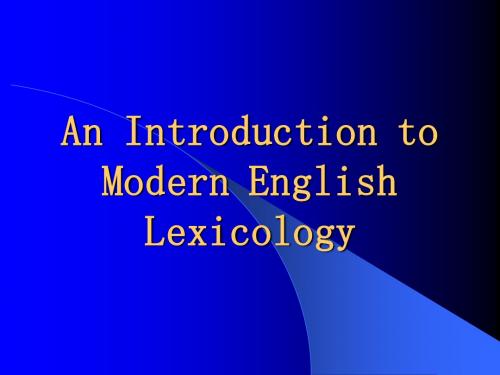
Lexicology
“Without grammar very little can be conveyed, without vocabulary nothing can be conveyed.”
General Introduction
Leonard Bloomfield(伦納德﹒布龙菲尔德) 1887-1949 Leonard Bloomfield was born in Chicago on April 18, 1887. His parents were Sigmund and Carola Buber Bloomfield. He came from a family of many high achievers. His aunt Fannie Bloomfield Zeisler had an international reputation as a concert pianist. His uncle Maurice Bloomfield, like Leonard, was a scholar in the field of linguistics. Maurice Bloomfield was Professor of Sanskrit and Comparative Philology at John Hopkins and was the second President of the Linguistic Society. In the mid-1890's, his father Sigmund took a position of proprietor at a hotel in Elkhart Lake, Wisconsin and moved the family there. Leonard was nine years old at that time and started attending the village school. At one time he failed to be promoted to the next grade and it was said that the village school did not agree with him. There was a family joke that the village school was too hard for him. But it could have been that he just didn't agree with the method of teaching. His mother tutored him and he was able to pass the then required high-school entrance examination. He moved to Chicago and entered the North Division School.
A BRIEF introduction to englishlexicology
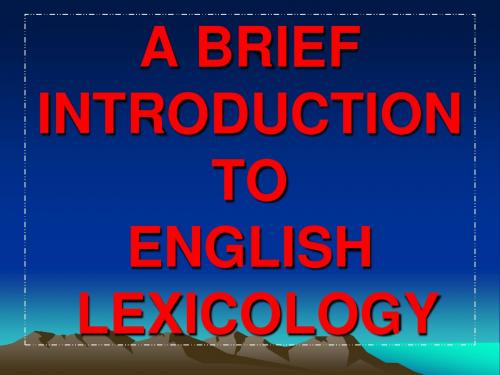
CHAPTER 1
LEXICOLOGY AND WORDS
1.1 1.2 1.3 1.4 1.5 1.6 1.7
1.8
Introduction What Is Lexicology? What Is a word The Connection of Lexicology with Other Branches of Linguistics Lexical and Grammatical Words Words and Semantic Fields Aims and Significance of the Course of English Lexicology Approaches to the Study of English Lexicology
Words in Linguistic Analysis
1. Phonology (音韵学;音位学) 2. Lexicology (词汇学) 3. Morphology (形态学) 4. Syntax (句法学) 5. Semantics (语义学) 6. Functional linguistics (功能语言学) 7. Sociolinguistics (社会语言学) 8. pragmatics (语用学) 9. Psycholinguistics (心理语言学) 10. Corpus linguistics (语料库语言学) 11. Discourse analysis (语篇分析)
Functions of Language
1. Social function Nhomakorabea. Psychological function
lexicology期末复习

PrefaceTwo respects of linguistics: words and word equivalents.The scope of lexicology: development, structure, formation, meaning and usage of words and words equivalents. Chapter One: a general survey of English vocabularyThe definition of word:(1) A word is a minimum free form. (Bloomfield)a. Classical statement;b. It holds good and can be applied to most cases;c. There are exceptions; not all words can occur in isolation;d. Does not touch upon meaning.(2) A word is defined by the association of a given sense with a given group of sounds capable of a givengrammatical use. (Antoine Meillet)a. A combination of meaning and sound with special emphasis on grammatical use;b. Useful but doesn‘t include the concept of word as the minimal free form.(3) A word may be defined as a fundamental unit of speech and a minimum free form; with a unity of soundand meaning (both lexical and grammatical meaning), capable of performing a given syntactic function.(4) Words are also either spoken or written.1.The Development of English Vocabulary (historical development and rapid growth) Vocabulary is the building material of a language----Stalin: Marxism and Problems of LinguisticsA. English vocabulary as viewed in the historical perspectiveOld English (OE) Or Anglo-Saxon(AS) (449-1100) a. The language of Angles, Saxons, and the Jutes replaced Celtic;b. contains fifty or sixty thousand words;c. chiefly Anglo-Saxon with a small mixture of Old Norse;d. borrow from Latin(especially after the introduction of Christianity into Britain in 597, Bible).Middle English(ME) (1100-1500) a. The strong influence of French because of the Norman Conquest in 1066b. Ruling class is French-speaking Normans; the masses continue to speak English;c. To the end of 15th century, English become once more the language of the whole country;d. Latin words continue to come in, but in small numbers.Modern English (1500--present) a.1500-1700, Renaissance, stress on study of classics, words borrowing from Latin;b. borrowing Greek words indirectly through the medium of Latin;c. introduces some Greek words directly into English vocabulary.English borrows wordsfrom a. 3 Romance languages: French, Spanish and Italianb. European languages: Portuguese, German, Dutch, Russianc. Non-European languages: Australian, Arabic, Indian, Hebrew, Chinese, Japanese, Africand. Vast debts: 80% of the entries are borrowed (The Encyclopedia Americana)English vocabulary is rich and heterogeneous and has the most copious vocabulary, more than a million words.B. The rapid growth of present-day English vocabulary (especially after World WarⅡ)The reason of the frequent appearance of neologisms (new words or new meaning for established words)(1)Marked progress of science and technology: the nuclear bomb, the exploration of space, computer science(2)Socio-economic, political and cultural changes: new social habits and new living condition, changes in domestic habits, drug addiction, student unrest, internal political struggle, women‘s liberation, struggle of the Black people, changes in education, new entertainment, sports.(3)The influence of other cultures and languages: an important factor in vocabulary development2. Classification of English Words According to Different Criteria(origin, level of usage, and notion)A. By Origin: native words and loan wordsLoan 20%used a. have been perfectly naturalized in usage;b. have conformed to native English in accent and spelling, sometimes even in adoption of an English affix, no longer aliens;c. words borrowed without any change in sound and spelling are known as foreign words.Native 80%used a. most are monosyllabic;b. auxiliary and modal verbs, and a greater part of numerals, pronouns, prepositions and conjunctions;c. top 9 most frequently used: and, be, have, it, of, the, to, will, you.The fundamental features of the basic word stocka. national character: they are known to all the membersb. stability: remain unchanged; a certain number of OE words have dropped out of basic word stockc. word-forming abilityd. ability to form collocations: combine to form habitual expressions and phrasesB. By level of usage1. Common a. connected with the ordinary things or activities necessary to everyday lifeb. stylistically neutral, both formal and informal2. Literary a. chiefly used in writing, especially in books written in a more elevated style, in official documents, or in formal speeches;b. most are of French, Latin and Greek origin;c. the use of literary words in ordinary conversation is pretentious or jocularArchaic words“arch.(aic)”a. no longer in common use, but retain for special purposeb. not obsolete words--dead words, obs.(olete) or dated., completely out of use Poetical words―poet.(ical)”a. traditionally used only in poetryBoth archaic and poetical---―arch. or poet.‖ a. most in pronominal forms3. Colloquial a. “colloq.(uial)” or infmlb. mainly in spoken English, among friends, colleagues and family4. Slang a. language, words or phrases of a vigorous, colorful, facetious, or taboo nature, invented forspecific occasions, or uses, or derived from the unconventional use of the standard vocabularyb. derogatory implication, unmeaning languagec. the reason of slang expressions is to secure freshness and noveltyd. lively, expressive, popular, and new expressions keep cropping up.e. can become ―respectable ‖ and achieve a lasting place5. Technical Or Special a. used in various special fieldsb. function—to denote things or processes and to increase precision in nomenclaturec. the use of technical terms save timed. sharply increased in the last 50 yearse. most remain essentially foreign to outsiders, even to educated native speakersf. the barrier between technical words and popular words is breaking downC. By notion: function words and content wordsPart of speech / word class LexicalmeaningGrammaticalmeaningamount stability useFunction determiners, conjunctions,prepositions, auxiliaries, and so forth.Not much Orno√Few,154 √highcontent Nouns, main verbs, adjectives andadverbs√×Many ×LowChapter 2 Morphological Structure of English words 词素结构1.Morphemes 词素A. Some basic information about morphemes1)Definition: the morpheme is the smallest meaningful linguistic unit, not divisible or analyzable into smaller meaningful forms.2)Duality: A morpheme is also a two-facet language unit with both sound and meaning.3)A morpheme is different from a phoneme(抽象,音位,[ ]). A phoneme only conveys sound distinction. (phone,具体,音素, / /)4)a morpheme is not identical with a syllable(音节).B. Allomorphs词素变体An allomorph is any of the variant forms of a morpheme as conditioned by position or adjoining sounds.2.Classification of MorphemesA. Free morphemes and bound morphemes 自由词素和粘着词素A free morpheme can be uttered aloneA bound morpheme cannot stand by itselfB. Roots and Affixes词根和词缀1)Roots: A root is the basic unchangeable part of a word and it conveys the main lexical meaning of word. Roots are either free or bound. Knowledge of roots can help one to analyze and understand many words almost on sight.a)Free roots: In English, many roots are free morphemes. A word consisting of one free root is a simple word.b)Bound roots: Derived from foreign sources, especially from Greek and Latin.2)Affixes:Affix is a ―collective term for the type of formative that can be used only when added to another morpheme‖.a)Inflectional affixes (or inflectional morphemes)曲折词缀:①An inflectional affix serves to express such meanings as plurality tense and the comparative orsuperlative degree. It doesn‘t form a new word with new lexical meaning.②It also doesn‘t change the word-class.③(-s;-en; genitive case ‗s; -s, -es; -d, -ed, -ing, -es; -er, -est)④The number of inflectional affixes is small and fixed; no new ones have been added since 1500.⑤Only have grammatical meaning⑥Can only be affixed to words of the same word-classb)Derivational affixes (or derivational morphemes): 派生词缀①Are those that derive a new word when added to another morpheme②Have specific lexical meanings③Have more than one meaning④Have affective meaning⑤Can be attached to words of different word-classes⑥New ones are coined from time to time.c)Both prefixes and suffixes may be grouped according to:①Their linguistic origin: native affixes & foreign affixes②Their productivity: productive or living & dead or unproductiveMorphemeFree Free rootBoundBound rootaffixInflectional affixesDerivational affixesPrefixesSuffixes3.A new criterion to classify English words: According to the number and type of morpheme they containChapter 3 Word-Formation(1)(The three major processes of word-formation)1.General remarksA. Percentage of new words coined by the different word-formation processes after World WarⅡ1)The three major processes of word-formationa)Compounding or composition—27%b)Derivation or affixation—17.5%c)Conversion—10.5%2)The eight minor processes of word-formationB. some basic concepts of word-formation1)Word-formation rules: the scope and methods whereby speakers of a language may create new words2)Root, stem, base: part of a word that remains when all affixes have been removed.A stem is the part of the word-form which remains when all inflectional affixes have been removed.A base is any form to which affixes of any kind can be added.pounding复合A. Definition1)Orthographic criteriona)Solidb)Hyphenatedc)Open2)Phonological criterionCompound accent: (‗___ ___ or ‗___ , ___)3)Semantic criteriona)The meaning of a compound is derived from the combined lexical meanings of its componentsb)The meaning of a compound is not always the sum of the meanings of it parts.c)A compound conveys a single idea, and functions as a separate lexical unit.B. Classification of Compounds1)Noun compounds: the commonest type; according to the syntactic relation of the compounding elements(String compound: a compound whose first element is itself a compound.)2)Adjective compounds: according to the syntactic relation of the compounding elements3)Verb compounds: by back-formation; by conversion.3.Derivation派生1)Definition: a process of forming new words by the addition of a word element, such as a prefix, suffix orcombining form or all, to an already existing word.2)Prefixation: adding a prefix or combining form; change the lexical meaning; do not change the word-classa)Classification of prefixation: by meaning①―negative‖-(un-, non-, in-, dis-, a-)②―reversative or privative‖-(un-,de-, dis-)③―pejorative‖-(mis-, mal-, pseudo-)④―prefixes of degree or size‖(arch-, super-, out-, sub-, over-, under-, hyper-, ultra-, mini-)⑤Prefixes of attitude(co-, counter-, anti-, pro-)⑥―locative‖ (super-, sub-, inter-, trans-)⑦Prefixes of time and order(fore-, pre-, post-, ex-, re-)⑧―number‖ prefixes(uni-/mono-, bi-/di-, tri-, multi-/poly-)b)Some productive prefixes P.45- P.493)Suffixation: the formation of a new word by adding a suffix or a combining form to the base, and usuallychanging the word-class of the basea)Classification of suffixes: according to the word-class of the word they formMain groups of suffixes:①Noun (-forming) suffixes: n-n; adj.-n; v.-v;②Verb (-forming) suffixes:③Adjective (-forming) suffixes: v.-adj.④Adverb (-forming) suffixesb)Some productive suffixes P.50- P.54c)Differentiating suffixes: convey subtle nuances of meaning4.Conversion转换A.Introductory remarks1)A word of a certain word-class is shifted into a word of another word-class without the addition of an affix.2)Change in the word-class, semantic change, phonological change.3)―F unctional shift‖ or ―derivation by zero suffix‖4)Conversion is a result of the almost entire loss of inflection5)The percentage of converted words is 10.5%6)Productive; because the inflectional endings is lost7)A word may undergo multiple conversionB. Types of conversion P.58—P.641)Noun—verb conversion2)Verb—noun conversion3)Adjective—verb conversion4)Adjective—noun conversion5)otherChapter 4 Word-formation (2)(The minor processes of word –formation)1.Acronymy: Initialisms and Acronyms 首字母缩略法A.I nitialisms1)Initialism is a type of shortening, using the first letters of words to form a proper name, a technical term, or aphrase;2)initialism is pronounced letter by letter;3)Three types;①The letters represent full words. Main type;②The letters represent elements in a compound or just part of a word;③ A letter represents the complete form of the first or the first two word, while the second word or thethird word is in full form;B.A cronyms1)Acronyms are words formed from the initial letters of the name of an organization or a scientific term.2)Pronounced as words rather than as sequences of letters3)P.73C.R apid growth of acronyms and initialisms1)As old as language itself2)Have become extremely popular since World WarⅡ3)Accelerated by the tremendous advances made in modern science and technology and by the increase inthe number of military, governmental, and voluntary organizations.4)The usual style or practice is to give the full when it is first mentioned and to follow it with the recognizedabbreviation in parenthesis.5)Many are colloquial and informal and should be avoided in formal writing.1)The process of clipping involves the deletion of one or more syllables from a word, which is available in its full form.2)A large number of clipped forms are regarded as informal and are used in less formal situations.3)The speech of students is filled with clippings.4)Typical characteristic of English: the tendency to shorten the English words.A.B ack clippings: the deletion occur at the end of the wordB.F ront clippings: the deletion occur at the beginning of the wordC.F ront and back clippings(not a common type of clipping): the deletion occur at both ends of a wordD.P hrase clippings: involves the shortening of a phrase3.Blending 拼缀法1)A new word is formed by combining the meanings and sounds of two soundsof two words, one of which is not in its full form or both of which are not in their full forms;2)a good many blends are journalistic coinages;3)frequently used by newspaper and magazines;4)most are short-lived novelties.A.T he first part of the first word + the last part of the second wordB.T he first part of the first word + the first part of the second wordC.W hole form of the first word + last part of the second wordD.F irst part of the first word + whole form of the second world4.Back-formation逆构词法1)Back-formation refers to a type of word-formation by which a shorter word is coined by the deletion of asupposed affix from a longer form already2)Many back-formations are created by analogy3)Some back-formations come from words ending in –s.4)The majority of back-formed words are verbs5)Of the many newly created back-formed verbs most are from nouns either ending in–tion or –er6)Less common are words formed by dropping prefixes7)On informal occasions5.Words from Proper Names: the coinage of common words from proper names.1)Words from the names of scientists2)Words from the names of politicians and statesmen3)Words from the names of places4)Words from trademarks5)Words from literature6.Reduplication 复制法1)A compound word is created by the repetition (1) of one word like go-go; (2) of two almost identical wordswith a change in the vowel‘s such as ping-pong; (3) of two almost identical words with a change in the initial consonants, as teenyweeny.2)Reduplicatives are characterized by being rhymed or alliterated3)The common uses are (1)to imitate sounds; (2)to suggest alternating movements; (3)to express one‘scontempt of the character, appearance and behaviour of a person; (4)to disparage by suggesting that something is in disorder, or of small value, or of inferior quality; (5) to show one‘s approval7.Neoclassical Formation 新古典构词法1)The process by which new words are formed from elements derived from Latin and Greek.2)In the nineteenth century, linguistic snobbery3)To add dignity and seriousness to a new word.8.MiscellaneousChapter 5 Word meaning and semantic features1.Conventionality and MotivationA.C onventionality1)Arbitrary: there is no intrinsic relation between the sound-symbol and its sense.2)Conventional: there is no way to explain why this or that sound-symbol has this or that meaning beyond thefact that the people of a given community have agreed to use one to designate the other.B.M otivation1)Motivation refers to the connection between word-symbol and its sense2)Motivation can arise in three major ways:①Phonetic motivationEchoic words or onomatopoeic words: pronunciation suggests the meaning②Morphological motivationA direct connection between the morphemic structure of the word and its meaning;Compound words may be morphologically motivated.③Semantic motivationThe figurative meaning provides motivation.2.Main types of word meaning: grammatical and lexicalA.G rammatical meaning: word-class and inflectional paradigm1)Word-class ( part of speech)2)Inflectional paradigm:①The set of grammatical forms of a word is called its paradigm②The lexical meaning of a word is the same throughout the paradigm③The grammatical meaning varies from one word-form to another.④Grammatical meaning is the same in identical sets of individual forms of different words.B.L exical meaning1)Denotative meaning:conceptual meaning; central factor; to designate or describe something; make communication possible2)Connotative meaning: association which a word or a phrase suggests in one‘s mindSupplementary value added to the purely denotative meaning;Pertaining to individuals and to a group.3)Social meaning: which a piece of language conveys about the social circumstances of its useIn terms of the social relationship, the occasion, subject matter and the mode of discourseFive different levels of formality: (1) oratorical or frozen (2) deliberate or formal (3) consultative (4) casual (5) intimate4)Affective meaning: concerned with the expression of feelings and attitudes of the speaker or writerPurr words: express the speaker‘s approvalSnarl words: show disapproval or contemptponential Analysis and semantic featuresA.C omponential analysis on the basis of semantic contrastThe analysis of word meanings is often seen as a process of breaking down the sense of a word into its minimal components, which are known as semantic features or sense components.B.A dvantages and disadvantages of componential analysis1)Some advantagesa)Enable us to have an exact knowledge of the conceptual meaning of wordsb)Help us to choose the right word or collocation2)Some disadvantagesa)We cannot find a set of features that capture what is common in meaning across lexical itemb)The analysis of word meaning into its sense components is not enoughChapter 6 Polysemy and Homonymy1.Polysemy多义现象A.D efinition1)To refer to a lexical item which has a range of different meanings.2)Polysemy is the rule; monosemy is the exception3)Polysemic words are signs of an advanced culture4)Polysemy is the feature of a language‘s economy and efficiency5)Some polysemic words have different affective and stylistic meanings.B.T wo approaches to polysemy: diachronic and synchronic历时研究法和共时研究法1)Diachronic: study the growth or change in the semantic structure of a word, or how the semantic structureof a word has developed from a primary meaning to the present polysemic state.2)Synchronic: study the comparative value of individual meaning and the international between the centralmeaning and secondary meanings.3)In some cases, the primary meaning (diachronically) and the central meaning (synchronically) coincide.4)In some cases, the meaning appeared after the original meaning can become the central meaning.C.T wo processes leading to polysemy1)RadiationSemantically, radiation is the process in which the primary or central meanings stands at the center while secondary meanings radiate from it in every direction like ray.2)ConcatenationConcatenation is a semantic process in which the meaning of a word moves gradually away from its first sense by successive shifts, until there is no connection between the sense that is finally developed and the primary meaning.2.HomonymyA.T ypes of homonyms1)Perfect homonyms: words are identical in sound and spelling but different in meaning2)Homophones: words are identical in sound but different in spelling and meaning3)Homographs: words are identical in spelling but different in sound and meaningB.S ources of homonyms1)Phonetic convergence语音趋同The most common cause of homonymyUnder the influence of phonetic changes, two or more words which once were different in sound forms take on the same pronunciation the spoken language.2)Semantic divergence语义分化Two or more meanings of the same word drift apart to such an extent that there will be no obvious connection between them.3)Foreign influence4)shortening3.The stylistic value of polysemy and homonymy1)The possibility of ambiguity leads to playing on words and leads to humour2)Polysemic words and homonymous words can also produce other aspects such as irony or heighteneddramatic powerChapter 7 Sense relations between words1.Synonymy 同义关系A.D efinition of synonyms―having the same essential meaning‖ and ―having essentially ide ntical definition‖B.K inds of synonyms1)Complete synonymsa)In scientific termsb)Two forces against complete synonymy:①Vagueness of word meaning②Connotative, stylistic and affective meanings that cluster around word2)Relative synonymsa)In degree of a given quality or in shade of meaning;b)Ineffective meaning, ad stylistic meaningc)In collocation and distributionC.S ynonymous patternsD.T he choice and appropriate use of synonyms1)Synonyms are extremely valuable stylistically in helping to avoid monotonous repetition and in achievingprecision.2)Other aspects:a)Synonyms of different word-classb)word synonymous with phrasesc)different sentence patterns expressing roughly the same idea2.Antonymy 反义关系A.T ypes of antonyms1)Antonyms classified on the basis of the semantic contrast:Contraries, complementaries, conversives2)Antonyms classified on the basis of morphological structureRoot antonyms and derivational antonymsB.S ome relevant points about antonyms1)Marked and unmarked members2)Some words without antonyms3)Different antonyms under different circumstances4)Lexical antonyms VS syntactic negation5)Word order of antonymous pairsC.U se of antonyms3.Hyponymy 上下义关系Hyponymy is the relationship which obtains between specific and general lexical items.A superordinate term or upper term & subordinate term or lower term4.Semantic field 语义场by Jost Triera)Semantic field theory took the view that the vocabulary of a given language is not simply a listing ofindependent items, but is organized into areas, or fields, within which words interrelate and define each other in various waysb)Word frequency in the same semantic field varies.c)The words of a semantic field are not synonymousd)Meaning resides not only in a word itself, but spreads over neighbouring words.e)Words in the same semantic field are likely to have a number of collocations in common.Chapter 8 Meaning and context1.Two types of contextsA.Linguistic context1)Lexical context2)Grammatical context3)Verbal contextB.Extra-linguistic context / context of situation1)The actual speech situation in which a word occurs2)The entire cultural background against which a word has to be set2.The vital role of context in determination of word meaningA.E liminating ambiguitiesAmbiguity refers to a word, phrase, sentence or group of sentences with more than one possible interpretation or meaning.B.C onveying emotional overtonesC.I ndicating referents and the range of the meaning of a word3.Suggested ways for the correct comprehension of word meaningA.T he use of an up-to-date and adequate monolingual dictionaryB.A good knowledge of the culture of the English-speaking peopleC.D evelopment of the ability to determine the meaning of a word from its contextChapter 9 Changes in word meaning1.Causes of changes in word meaningA.H istorical causeThe object which a word denotes has changed.B.S ocial causeA constant verbal traffic between common words and various technical wordsC.F oreign influenceD.L inguistic cause: ellipsis and analogyE.Psychological cause: euphemism; grandiloquence; cynicismF.Cause by figurative use of wordsMetaphorMetonymy2.Four tendencies in semantic changeA.R estriction of meaning (specialization)A word of wide meaning acquires a narrower, specialized sense which is applicable to only one of the objectsit had previously denoted.B.E xtension of meaning (generalization)The widening of a word‘s sense until it covers much more than what it originally conveyed.C.D egeneration of meaning (pejoration)1)One form: The falling of word meaning into disrepute, for one reason or another2)The second form: take the form of the gradual extension to so many senses that any particular meaningwhich a word may have had is completely lost.D.E levation of meaning (amelioration)A word meaning takes on a turn for the better in the course of time.。
词汇学
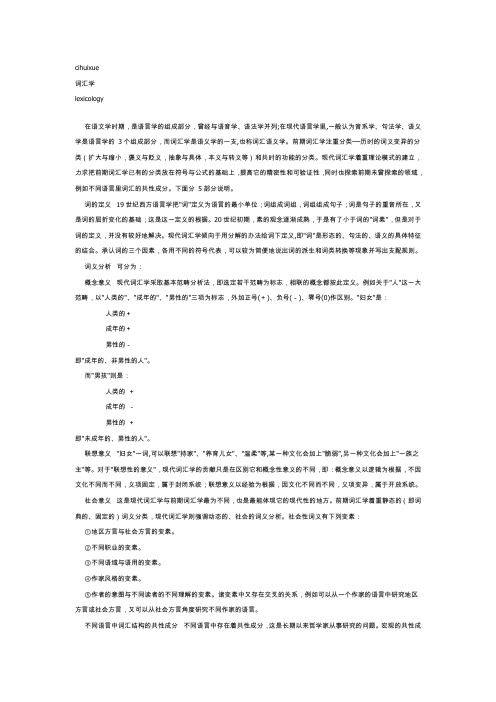
cihuixue词汇学lexicology在语文学时期,是语言学的组成部分,曾经与语音学、语法学并列;在现代语言学里,一般认为音系学、句法学、语义学是语言学的3个组成部分,而词汇学是语义学的一支,也称词汇语义学。
前期词汇学注重分类──历时的词义变异的分类(扩大与缩小,褒义与贬义,抽象与具体,本义与转义等)和共时的功能的分类。
现代词汇学着重理论模式的建立,力求把前期词汇学已有的分类放在符号与公式的基础上,提高它的精密性和可验证性,同时也探索前期未曾探索的领域,例如不同语言里词汇的共性成分。
下面分5部分说明。
词的定义19世纪西方语言学把"词"定义为语言的最小单位;词组成词组,词组组成句子;词是句子的重音所在,又是词的屈折变化的基础;这是这一定义的根据。
20世纪初期,素的观念逐渐成熟,于是有了小于词的"词素",但是对于词的定义,并没有较好地解决。
现代词汇学倾向于用分解的办法给词下定义,即"词"是形态的、句法的、语义的具体特征的结合。
承认词的三个因素,各用不同的符号代表,可以较为简便地说出词的派生和词类转换等现象并写出支配规则。
词义分析可分为:概念意义现代词汇学采取基本范畴分析法,即选定若干范畴为标志,相联的概念都按此定义。
例如关于"人"这一大范畴,以"人类的"、"成年的"、"男性的"三项为标志,外加正号(+)、负号(-)、零号(0)作区别。
"妇女"是:人类的+成年的+男性的-即"成年的、非男性的人"。
而"男孩"则是:人类的+成年的-男性的+即"未成年的、男性的人"。
联想意义"妇女"一词,可以联想"持家"、"养育儿女"、"温柔"等,某一种文化会加上"脆弱",另一种文化会加上"一族之主"等。
Lexicology
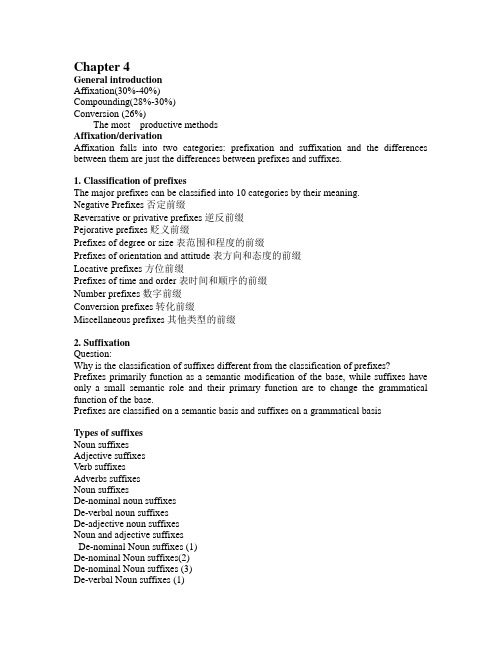
Chapter 4General introductionAffixation(30%-40%)Compounding(28%-30%)Conversion (26%)The most productive methodsAffixation/derivationAffixation falls into two categories: prefixation and suffixation and the differences between them are just the differences between prefixes and suffixes.1. Classification of prefixesThe major prefixes can be classified into 10 categories by their meaning.Negative Prefixes否定前缀Reversative or privative prefixes逆反前缀Pejorative prefixes贬义前缀Prefixes of degree or size表范围和程度的前缀Prefixes of orientation and attitude表方向和态度的前缀Locative prefixes方位前缀Prefixes of time and order表时间和顺序的前缀Number prefixes数字前缀Conversion prefixes转化前缀Miscellaneous prefixes其他类型的前缀2. SuffixationQuestion:Why is the classification of suffixes different from the classification of prefixes? Prefixes primarily function as a semantic modification of the base, while suffixes have only a small semantic role and their primary function are to change the grammatical function of the base.Prefixes are classified on a semantic basis and suffixes on a grammatical basisTypes of suffixesNoun suffixesAdjective suffixesVerb suffixesAdverbs suffixesNoun suffixesDe-nominal noun suffixesDe-verbal noun suffixesDe-adjective noun suffixesNoun and adjective suffixesDe-nominal Noun suffixes (1)De-nominal Noun suffixes(2)De-nominal Noun suffixes (3)De-verbal Noun suffixes (1)De-verbal Noun suffixes (2)De-adjective Noun suffixes (1)De-adjective Noun suffixes (2)De-adjective Noun suffixes (2)Noun and adjective suffixesSome suffixes, when added to bases related to human beings or nationality names, yield words that can be used both as nouns and adjectives.-ese: Chinese; Lebanese; officialese-an, -ian: Australian, Cambodian-ist: racist, socialist-ite: Chomskyite, Thatcherite4.2 Compounding复合法The definition of compounding and compoundCharacteristics of compoundsPhonological featuresSemantic featuresGrammatical featuresOrthographical features3. Formation of CompoundsNoun compoundsAdjective compoundsVerb compoundsThrough conversion: nickname; first-nameThrough backformation: lip-reading to lip-readchain-smoker to chain-smoke4.3 Conversion转化法Question:What is conversion? Why is it called zero-derivation?change of word-class; functional shiftderivation process without the addition of an affixTypes of ConversionConversion to NounsConversion to VerbsConversion to AdjectivesWords produced by conversion are primarily nouns, adjectives and verbs, among which the conversion between nouns and verbs are the most productive.Conversion to nounsDe-verbalDe-adjectivalMiscellaneous conversion1) Deverbal (由动词转化而来的名词)Almost all monomorphemic (单语素结构的)verbs can be used as nouns,which are semantically related to the original verbs in various ways.State (of mind or sensation) (doubt; want; desire)Event or activity( search; laugh; teach-in)Result of the action (catch; find, answer)Doer of the action( help; cheat, bore)Tool or instrument to do the action with (cover; wrap)Place of the action (pass; walk; divide)2) De-adjectival 由形容词转化成的名词Full conversion完全转换:A noun fully converted from an adjective has all the characteristics of nouns.It can take an indefinite article or –(e)s to indicate singular or plural number.Partial conversion 部分转换Nouns partially converted from adjectives do not possess all the qualities a noun does. They must be used together with definite articles as nouns while retaining some of the adjective features.The gradable adjectives can keep their comparative or superlative degrees.Words in this category generally denote a group of the kind.3). Miscellaneous conversion其他类型的转换Nouns converted from other classes as conjunctions, modals, finite verbs, prepositions, etc.Conversion to verbsThe use of the verb converted is both economical and vivid.Three kinds of conversion to verbsDenominal: to pocket the money; the nurse the babyDe-adjectival: The photograph yellowed with age.Miscellaneous conversion: The students tut-tut the idea.Conversion to adjectivesIt occurs mostly between nouns and adjectives.Less productive Word-formationBlendingClippingAcronymyBackformationSound reduplicationCommonization of proper namesBlending 拼缀法DefinitionClassificationFeatures of blendsFive types of blending according to their morphological structuresHead + tail: The first part of the first word + the last part of the second one:Head + head: the first part of the first word + the first part of the second oneHead + word: the first part of the first word + whole form of the second oneWord + tail: whole form of the first word + the last part of the second oneWord + head: whole form of the first word + first part of the second oneFeatures of BlendsThe overwhelming majority of blends are nouns, very few are verbs and adjectives are even fewer.The relation of the components of a blend can be classified into two kinds: the two parts may enjoy equal status and can be connected by ―and‖ as in ―brunch‖ or one component is the modificator of the other as in ―psywar‖.particularly common in commercial and journalistic language( newspapers and magazines) and in writing related to science and technologyClipping 截短法DefinitionReasons for using clippingTypes of clippingCharacteristics of clippingsTypes of clippingFront clippingBack clippingFront and back clippingPhrase clippingFeatures of clippingsClippings may give rise to alterations in spelling and pronunciation.Clippings may vary with social classes, groups or occupations, certain locutions are peculiar to their own groups.The sportsman has ref (=referee). The schoolgirl has her hols(=holidays) and prep (=preparation of school work). But the college students has his exam, prof, math, lab, trig and gym.Features of clippingsA few of the clipped words like taxi, plane, bus are now accepted in the common core vocabulary of the English language. They have replaced their originals and some peopleare no longer aware that bus was clipped from omnibus and taxi from taxicab. Stylistically speaking, clipped words are generally used in less formal situations than their full-length equivalents. Most of them are regarded to be informal and colloquial. But there are still some cases in which the original forms are regarded as bookish and people prefer the clipped words. e.g lunch (luncheon)Acronymy 首字母缩略法DefinitionTwo types of acronyms depending on the pronunciation of the wordsinitialisms首字母缩略词acronyms 首字母拼音词Backformation逆生法DefinitionClassificationThe method of creating words by removing the supposed suffixes, so called because many of the removed endings are not suffixes but inseparable parts of the words.去掉所谓的后缀而产生新词的方法,这是因为许多被去掉的后缀不是真正的后缀,而是单词不可分割的部分。
英语词汇学名词解释
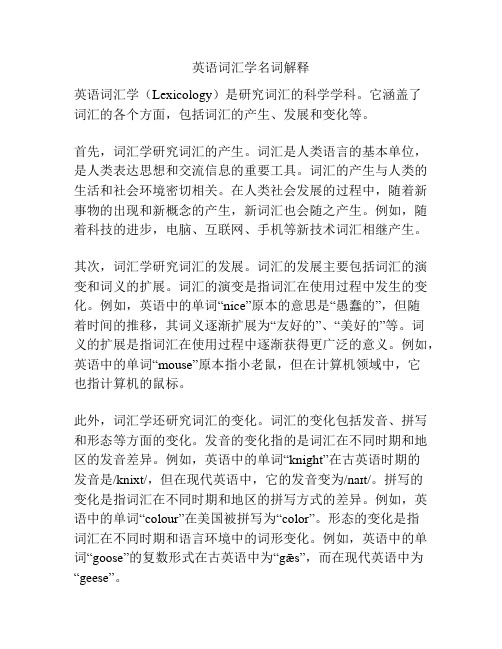
英语词汇学名词解释英语词汇学(Lexicology)是研究词汇的科学学科。
它涵盖了词汇的各个方面,包括词汇的产生、发展和变化等。
首先,词汇学研究词汇的产生。
词汇是人类语言的基本单位,是人类表达思想和交流信息的重要工具。
词汇的产生与人类的生活和社会环境密切相关。
在人类社会发展的过程中,随着新事物的出现和新概念的产生,新词汇也会随之产生。
例如,随着科技的进步,电脑、互联网、手机等新技术词汇相继产生。
其次,词汇学研究词汇的发展。
词汇的发展主要包括词汇的演变和词义的扩展。
词汇的演变是指词汇在使用过程中发生的变化。
例如,英语中的单词“nice”原本的意思是“愚蠢的”,但随着时间的推移,其词义逐渐扩展为“友好的”、“美好的”等。
词义的扩展是指词汇在使用过程中逐渐获得更广泛的意义。
例如,英语中的单词“mouse”原本指小老鼠,但在计算机领域中,它也指计算机的鼠标。
此外,词汇学还研究词汇的变化。
词汇的变化包括发音、拼写和形态等方面的变化。
发音的变化指的是词汇在不同时期和地区的发音差异。
例如,英语中的单词“knight”在古英语时期的发音是/knixt/,但在现代英语中,它的发音变为/naɪt/。
拼写的变化是指词汇在不同时期和地区的拼写方式的差异。
例如,英语中的单词“colour”在美国被拼写为“color”。
形态的变化是指词汇在不同时期和语言环境中的词形变化。
例如,英语中的单词“goose”的复数形式在古英语中为“gǣs”,而在现代英语中为“geese”。
总之,英语词汇学研究词汇的产生、发展和变化,揭示了词汇在语言中的重要地位和作用。
通过深入研究词汇,我们可以更好地理解和运用英语,提高我们的语言能力。
lexicology
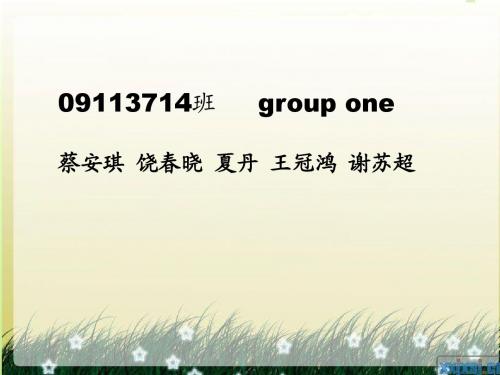
de-与名词结合
• 1.degrade【de- = to make down使向下;grade 级别→to make down from one’s grade使某人级 别下降】vt. Reduce to a lower rank使降低,贬黜 • 2. derail【de- = to cause away from使离开;rail 铁轨】vt. cause to run away from the rails使脱轨 • 3. dethrone【de- =to remove from; throne王位 】 vt. Remove from a throne or ruling废除,罢免
Precept
(before&in advance) (take,seize) Precept
→
Pre (prefix)
+
ceቤተ መጻሕፍቲ ባይዱt (root)
(master word) (准则,规范) 准则,规范) 准则
Root spelling : capere <FROM LATIN> Other spelling : cept, cap, capt, ceiv, ceit,
E.G.:
predict 预言 预报 预言,预报 预报→(pre+dict说→预先说 预言 预先说→预言 说 预先说 预言) precaution 预防措施 预防措施→(pre+caution小心 预先小心 预防 小心→预先小心 预防) 小心 预先小心→预防
-cept (take,seize) )
E.G.:
capacity 容量,才能 → (cap+acity能力 拿住的能力 容 容量, 能力→拿住的能力 能力 拿住的能力→容 才能) 量;才能 才能
- 1、下载文档前请自行甄别文档内容的完整性,平台不提供额外的编辑、内容补充、找答案等附加服务。
- 2、"仅部分预览"的文档,不可在线预览部分如存在完整性等问题,可反馈申请退款(可完整预览的文档不适用该条件!)。
- 3、如文档侵犯您的权益,请联系客服反馈,我们会尽快为您处理(人工客服工作时间:9:00-18:30)。
2017/9/28
8
Study Methods
1 Combination of Macroscopic and Microscopic Perspective 2. Combination of Understanding and Memory, Theory and Practice 3. Combination of Comparison and Contrast
2.To understand the basic elements of lexicological theories and their applications
3. To learn the origin and evolution of words and the methodology of lexicological studies 4. To build up vocabulary in more effective ways 5. To acquaint with English idioms and idiomatic ways of expression 6.To prepare for the future research work
sound and meaning. A fourth field of particular interest in lexicological studies is etymology, the study of the origins of words.
2017/9/28 12
Word-Word Stock-Definition
•
e.g. Your candid opinion will not be appreciated even when you spill your guts.
2
2017/9/28
The Goals for this Course
1.A credit oriented Compulsary Course
A unit of language, consisting of one or more spoken sounds or their written representation, that functions as a principal carrier of meaning. Words are composed of one or more morphemes and are either the smallest units susceptible of independent use or consist of two or three such units combined under certain linking conditions.(e.g. blackbird) Words are usually separated by spaces in writing, and are distinguished phonologically, as by accent, in many languages.
• Limited exposure to the multiple meanings of words
• e.g. His name was struck off the waiting list
• Difficulty with English idioms and their applications
e.g.: The current meaning of the word wife, it means a married woman, in relation to her husband. But from the diachronic point of view, which concerns the word historically, looking into its origin and changes in form and meaning, we know that, wife is from the old English wif, meaning woman, but latter, it has become specialized in the course of development to the modern meaning a married woman.
cost, this will tend to increase the supply offered by seller-producers, which in turn will lower the price and permit more consumers to buy the product.
minerals, more or less impure, in which aluminum is present as hydrated oxides
• Got baffled by words in sentences with complicated structures • e.g. If, on the other hand, producing more of a commodity results in reducing its
4. Combination of Reading and Exe Nhomakorabeacises
2017/9/28
9
Methods of Study: Synchronic and Diachronic Study
When words are studied at a point in time, disregarding whatever changes might be taking place, we call it synchronic study. While taking into account the meaning change over time, we may delve into the root of the word.
2017/9/28 11
Further Theoretical Studies
Lexicology deals not only with simple words in all their aspects but also with complex and compound words, the meaningful units of language. Since these units must be analysed in respect of both their form and their meaning, lexicology relies on information derived from morphology, the study of the forms of words and their components, and semantics, the study of their meanings. Phonetics is the study of speech sounds made in spoken, without speech sound, there is no word because every word is a unity of
Welcome to Lexicology
A Way to Enlarge Your Scope in English Language
Monique Luo 2017
2017/9/28 1
Vocabulary Puzzles
• Limited vocabulary and troubled with vocabulary building • e.g. The best aluminum ore is bauxite, defined as aggregates of aluminous
2017/9/28
3
The Requirements for this course
Class attendance
Classroom performances
Fulfillment of the assignment (memory of basic concepts is required) Examination
2017/9/28
7
Useful Links
• /186/ • https:///wiki/Edward_Sapir • https:///what-is-lexicology1691230
• A word is a speech sound or combination of sounds having meaning and used as a basic unit of language and human communication. —— Longman Modern English Dictionary
《词义和释义》 孙良明 湖北人民出版社 1982年
2017/9/28
5
Reference Books
Linguistics H.G. Widdowson 《语言学》,牛津语言学入门丛书,上海外语教育出版社, 2000 Linguistics: An Advanced Course Book 《语言学高级教程》胡壮麟,姜望琪主编,北京大学出版社 The Cambridge Encyclopedia of Language (Second Edition), David Crystal《剑桥语言百科全书》
2017/9/28
10
Lecture I: Introduction to the Course
Aspects of Words
Lexicology is the branch of linguistics that studies the stock of words (the lexicon) in a given language. It deals with words, their origin, development, history, structure, meaning and application. It is the study of the signification and application of words., aiming at investigating the morphological structures, semantic structures, relations, formation and usages. It is a theoretically-oriented course as well as a practical course.
